SAREF extension for smart grid
- Latest version:
- https://saref.etsi.org/saref4grid/
- Permanent IRI for this version (v1.1.1)
- https://saref.etsi.org/saref4grid/v1.1.1/
- ETSI Technical Specification
- https://www.etsi.org/deliver/etsi_ts/103400_103499/10341012/01.01.01_60/ts_10341012v010101p.pdf
- Sources on the SAREF Forge
- https://saref.etsi.org/sources/saref4grid/
- Publication Date
- 2023-11-22
- Last Modification Date
- 2023-11-22
- Creators
-
Raúl García-Castro (Universidad Politécnica de Madrid)
Sergio-Mario Carulli-Pérez (Universidad Politécnica de Madrid)
María Poveda-Villalón (Universidad Politécnica de Madrid) - Ontology requirements and tests
- requirements and tests
- Prefix and namespace declaration:
- Turtle:
@prefix s4grid: <https://saref.etsi.org/saref4grid/> .- SPARQL:
PREFIX s4grid: <https://saref.etsi.org/saref4grid/> - Download serialization:
-
- License:
-
Table of Content
Introduction
This document presents the implementation of the SAREF extension for the electric grid domain (SAREF4GRID).
General overview
Figure 1, Figure 2, Figure 3 and Figure 4 present an overview of the classes and the properties included in the SAREF4GRID extension.
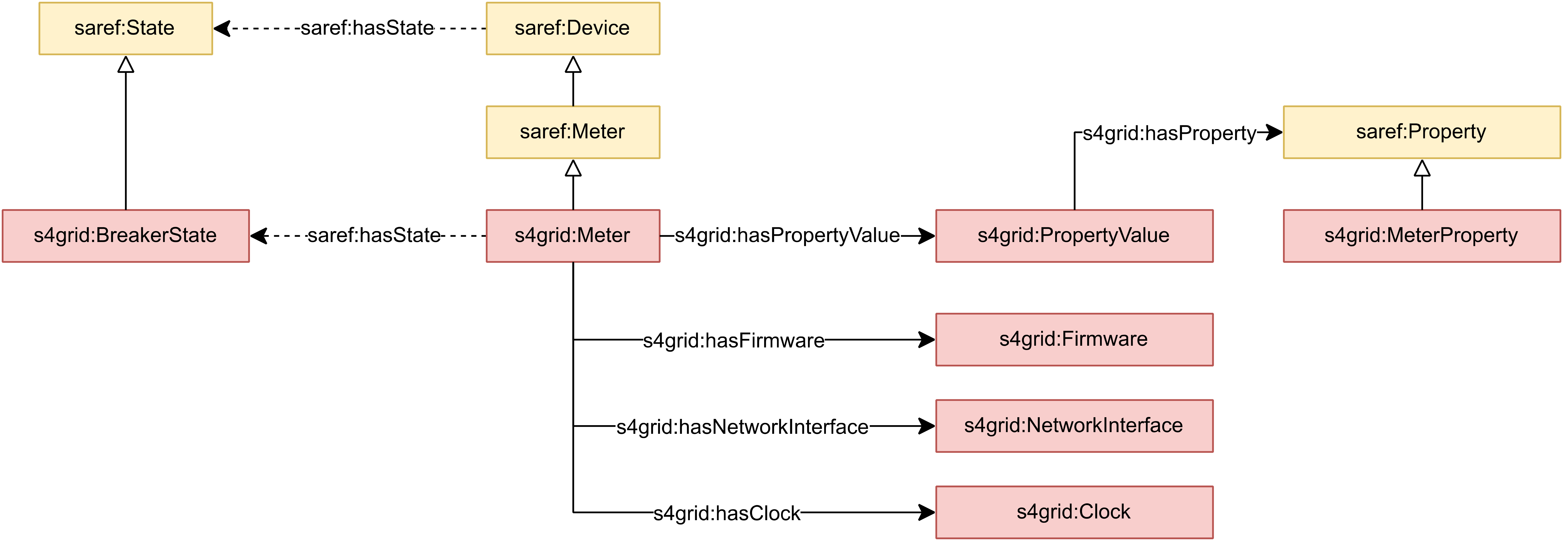

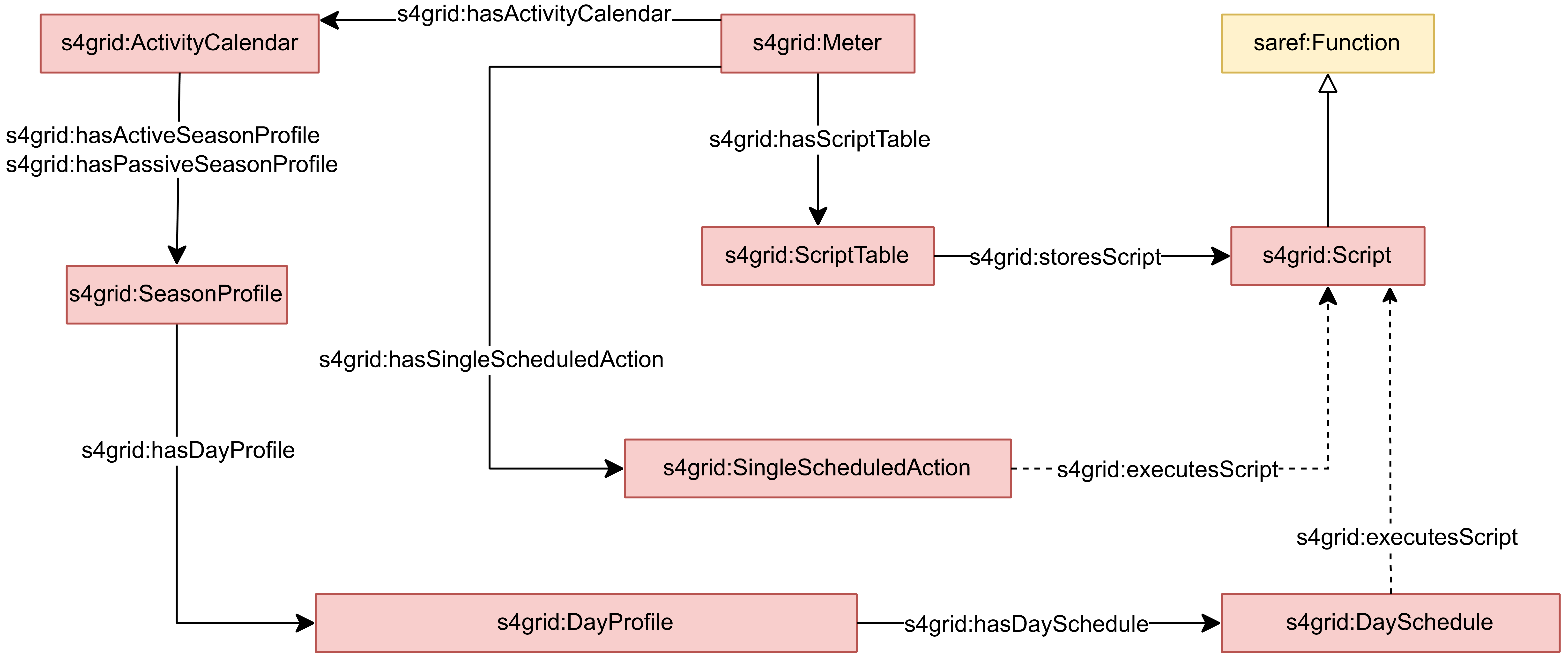
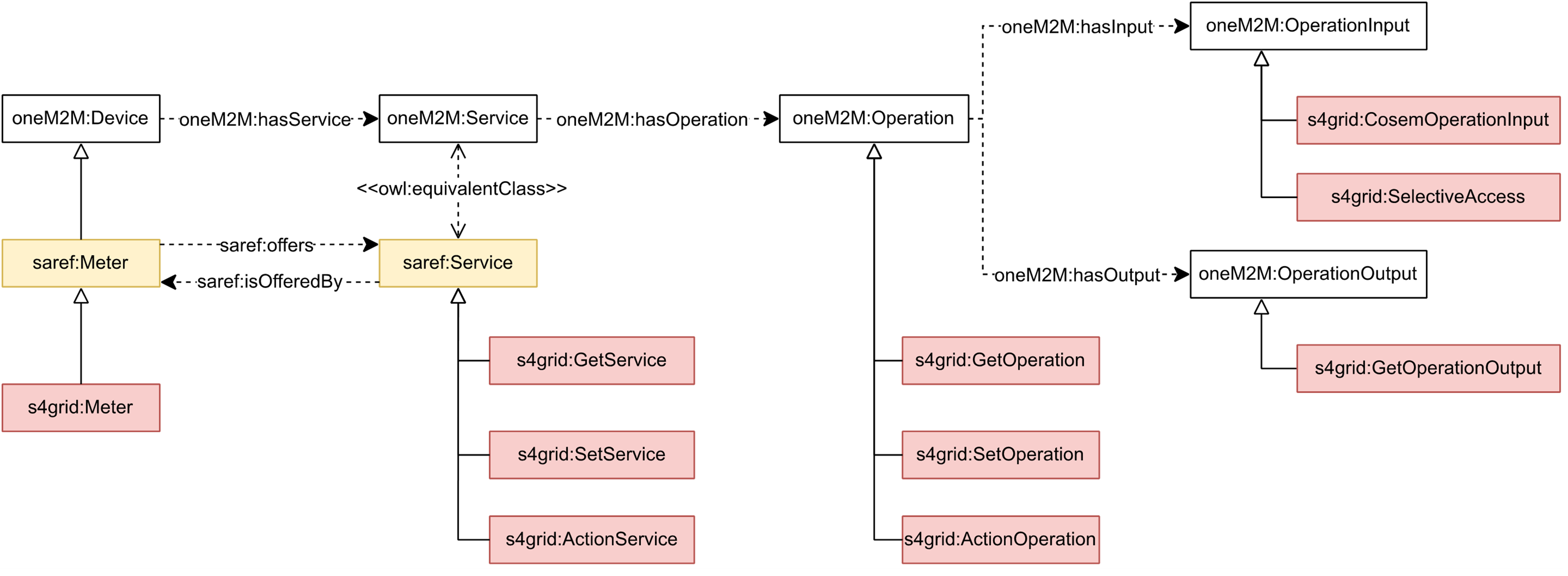
Meter
Figure 5 provides an overview of how to represent an electric grid meter using the s4grid:Meter class. The representation of electric grid meters and their properties has been extracted from the DLMS/COSEM standard (IEC 62056)
Unlike in other SAREF extensions, meter-specific information is not defined using properties from SAREF. This is because the DLMS/COSEM standard defines the data structures to model meters from simple up to very complex functionality (IEC 62056-6-2:2017). Moreover, each piece of information within the metering equipment has a unique identifier called OBIS (OBject Identification System) which identifies the instance of a COSEM object (IEC 62056-6-1:2017). This data includes not only measurement values, but also abstract values used for configuration or for obtaining information about the behaviour of the metering equipment.
For this reason, the characteristics of the meter are represented as properties that are not observable by the meter (s4grid:MeterProperty, fully represented in Figure 6), i.e., they are not measurements (saref:Measurement). The properties of a meter are defined by a value (s4grid:PropertyValue) and some are complemented with a unit of measurement (saref:UnitOfMeasure).
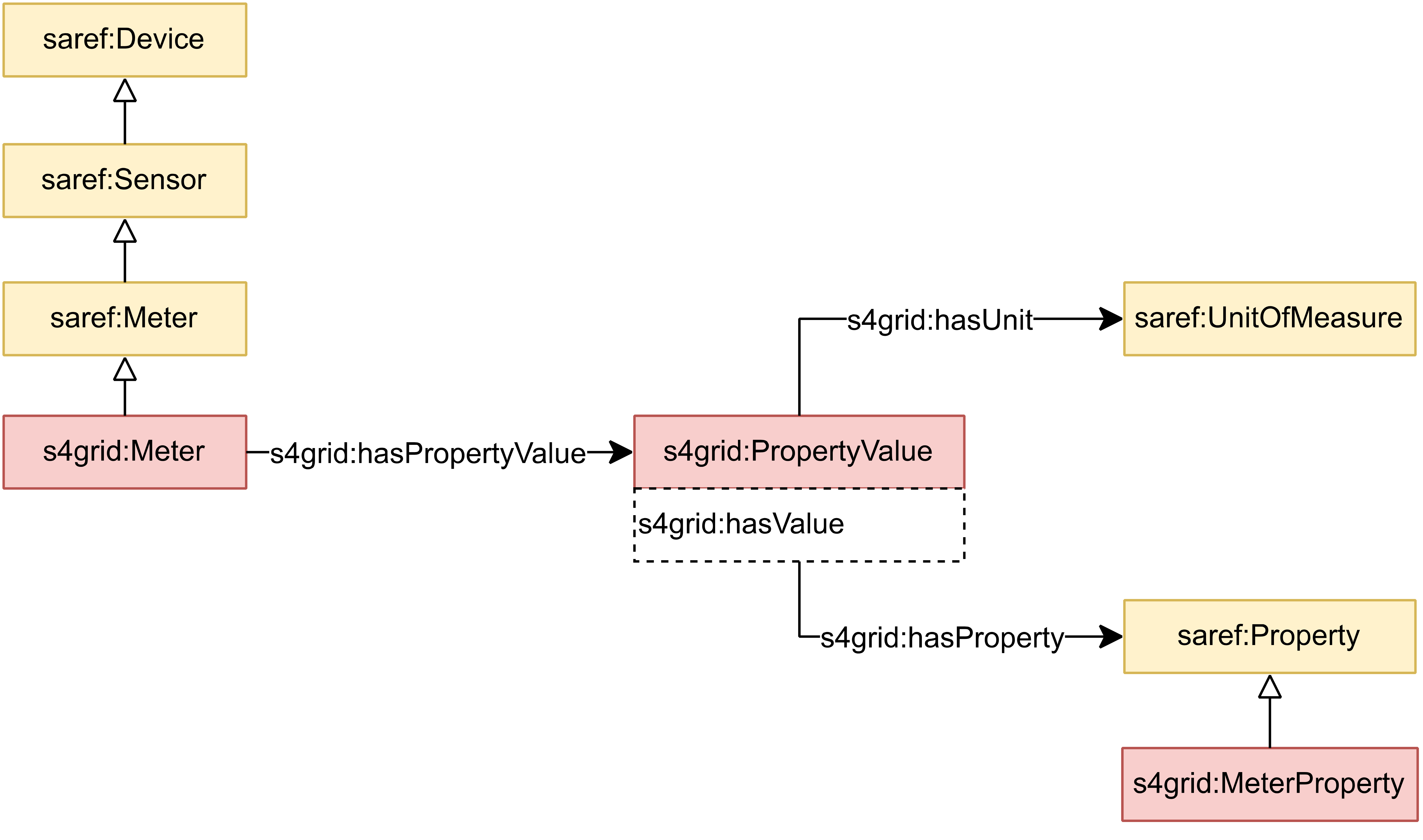
Meters store internal configuration parameters. The DLMS/COSEM standard (IEC 62056) defines properties related to the configuration of a meter that are necessary to ensure its correct operation. SAREF4GRID categorises the main properties related to the configuration of a meter (s4grid:MeterProperty): screen display configuration (s4grid:ScreenDisplay), electric threshold values (s4grid:Threshold), time from which a measure has to be outside the threshold before to be considered a quality issue (s4grid:TimeThreshold), number of voltage sags (s4grid:VoltageSagNumber), number of voltage swells (s4grid:VoltageSwellNumber), number of long power failures (s4grid:LongPowerFailuresNumber), information provided by the manufacturer (s4grid:Manufacturer), turn ratio of the transformer (s4grid:TransformerRatio), communication configuration (s4grid:Network), status of meter profiles (s4grid:ProfileStatus), client power limits (s4grid:PowerLimit), references values for power quality (s4grid:PowerQuality), client billing periods (s4grid:BillingPeriod), information about the electric grid phase (s4grid:Phase), information about the electric grid phase angle (s4grid:PhaseAngle) and electric quadrant (s4grid:Quadrant). It should be noted that in SAREF4GRID only the general properties are being defined. In order to use a more specific property it is advisable to indicate the general property it comes from (if it exists). These properties are depicted in Figure 6.
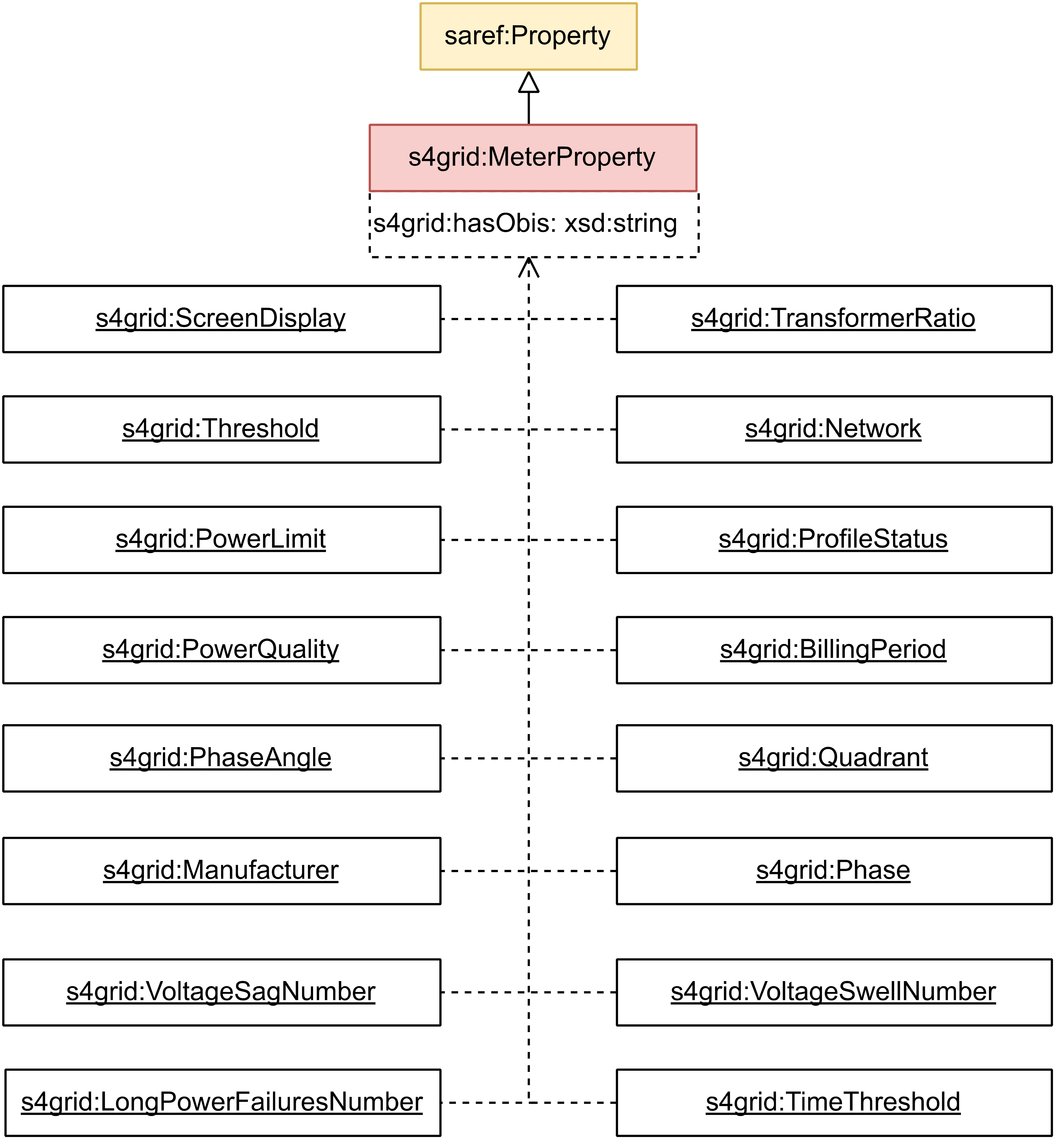
Firmware
SAREF4GRID allows describing the identification information related to administration and maintenance of meters by means of the s4grid:Firmware class, as presented in Figure 7. They are not communication parameters but support device management. The representation of the firmware of a meter has been extracted from the IEC 62056-6-2:2017.
A meter firmware may be described by its: version (s4grid:hasFirmwareVersion), unique vendor identifier (s4grid:hasVendorId) and unique product identifier assigned by the vendor (s4grid:hasProductId). Besides, a firmware can be related to an electric grid meter by means of the s4grid:hasFirmware property.

Network Interface
SAREF4GRID allows describing the MAC address of the physical device (or, more generally, of a device or software) by means of the s4grid:NetworkInterface class, as presented in Figure 8. There shall be an instance of this class for each network interface of a meter. The representation of the network interface of a meter has been extracted from the IEC 62056-6-2:2017.

Clock
SAREF4GRID allows describing the clock of a meter by means of the s4grid:Clock class, as presented in Figure 9. This clock manages all information related to date and time including deviations of the local time to a generalized time reference (UTC) due to time zones and daylight-saving time schemes. The representation of the meter clock has been extracted from the IEC 62056-6-2:2017.
A meter clock may be described by its: time (s4grid:hasTime), time zone where the meter is located (s4grid:hasTimeZone), clock status maintained by the meter (s4grid:hasStatus), date at which the local time starts to deviate from the normal time (s4grid:hasDaylighhtSavingsBegin), date at which the local time ends to deviate from the normal time (s4grid:hasDaylighhtSavingsEnd), deviation in generalized time (s4grid:hasDaylightSavingsDeviation), if the daylight savings time feature is enabled (s4grid:hasDaylightSavingsEnabled) and where the basic timing information comes from (s4grid:hasClockBase). Besides, a clock can be related to an electric grid meter by means of the s4grid:hasClock property.
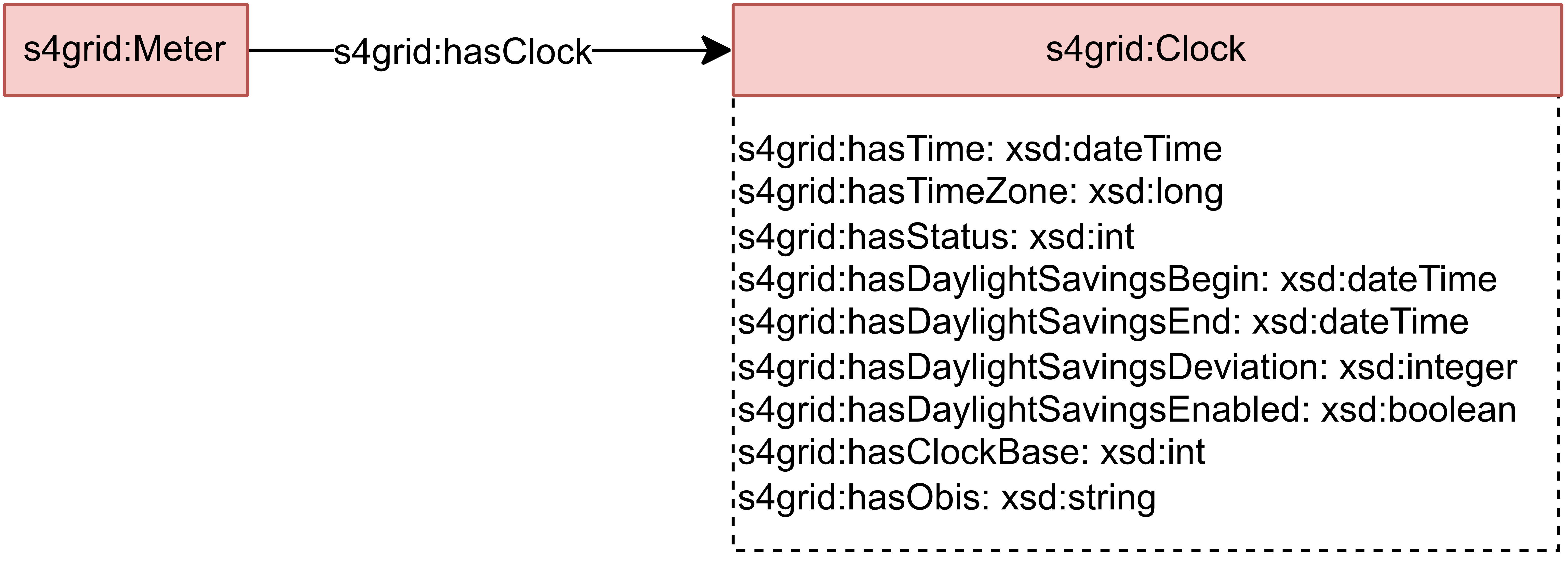
Breaker State
As it can be observed in Figure 10, the modelling of states in the SAREF4GRID ontology mostly relies on the state model proposed in SAREF.
SAREF allows to define the state in which a device can be found. However, the SAREF4GRID extension also requires to be able to define the possible transitions between states and complex states. Therefore, the s4grid:BreakerState class has been defined according to the IEC 62056-6-2:2017.
A meter breaker state represents the internal or external disconnect unit of the meter (e.g., electricity breaker, gas valve) in order to connect or disconnect the premises of the consumer to/from the supply. A meter breaker state may be described by its: physical state (s4grid:hasOutputState), internal state (s4grid:hasControlState) and the possible transitions between states (s4grid:hasControlMode).
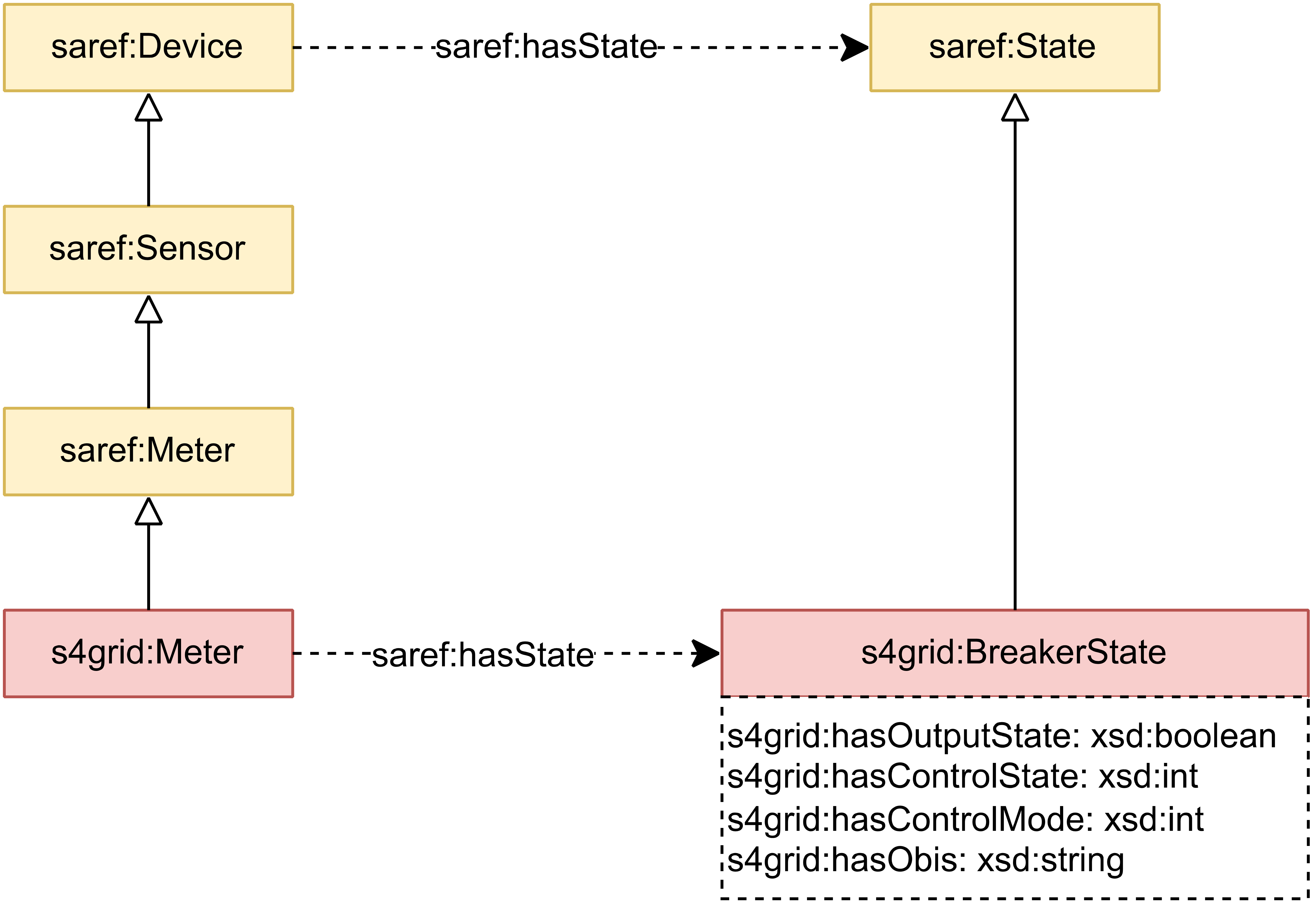
Script Table
As it can be observed in Figure 11, the modelling of scripts in the SAREF4GRID ontology mostly relies on the service model proposed in SAREF. In order to reduce duplication with SAREF documentation, the reader is referred to the SAREF specification for details about service modelling including here details only for the new concepts.
SAREF allows to define the functions which accomplish the task for which a device is designed. However, the SAREF4GRID extension also requires to be able to define the triggering of a series of actions by executing scripts, and where those scripts are stored. Therefore, the s4grid:ScriptTable class has been defined according to the IEC 62056-6-2:2017.
A script table represents a table of script entries. Moreover, the s4grid:Script class defines a series of action specifications. An action specification activates a method or modifies an attribute of a COSEM object within the logical device. Besides, a script table can be related to an electric grid meter by means of the s4grid:hasScriptTable property.
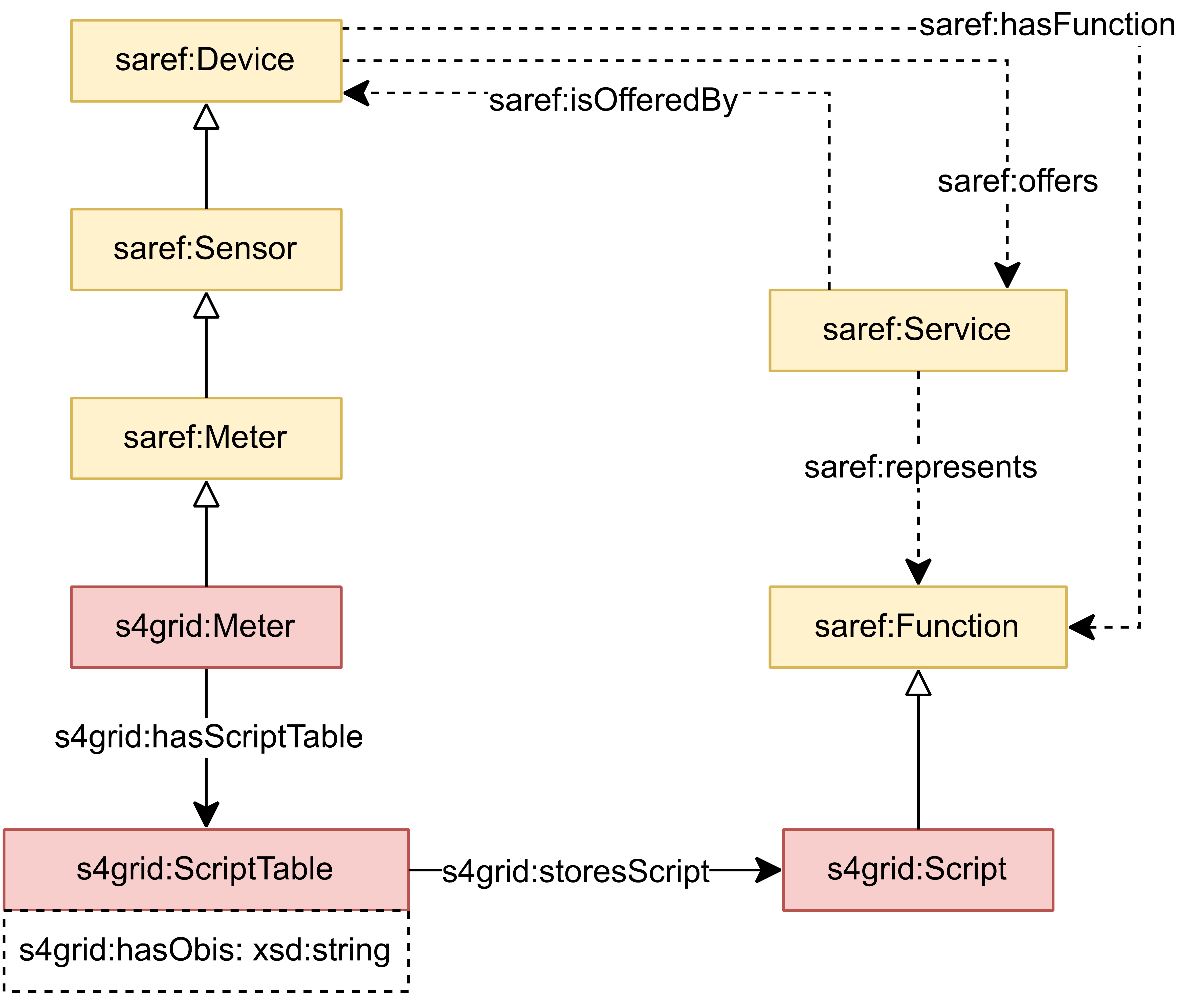
Scheduled Action
SAREF4GRID allows the execution of periodic actions within a meter by means of the s4grid:SingleScheduledAction class, as presented in Figure 12 ; such actions are not necessarily linked to tariffication. A scheduled action describes the script, which is stored in a script table, that is going to be executed at a determined date. The representation of the meter scheduled action has been extracted from the IEC 62056-6-2:2017.
A meter single scheduled action may be described by its: execution time (s4grid:hasExecutionTime) and what script is going to be executed (s4grid:executesScript). Besides, a single schedule action can be related to an electric grid meter by means of the s4grid:hasSingleScheduledAction property.
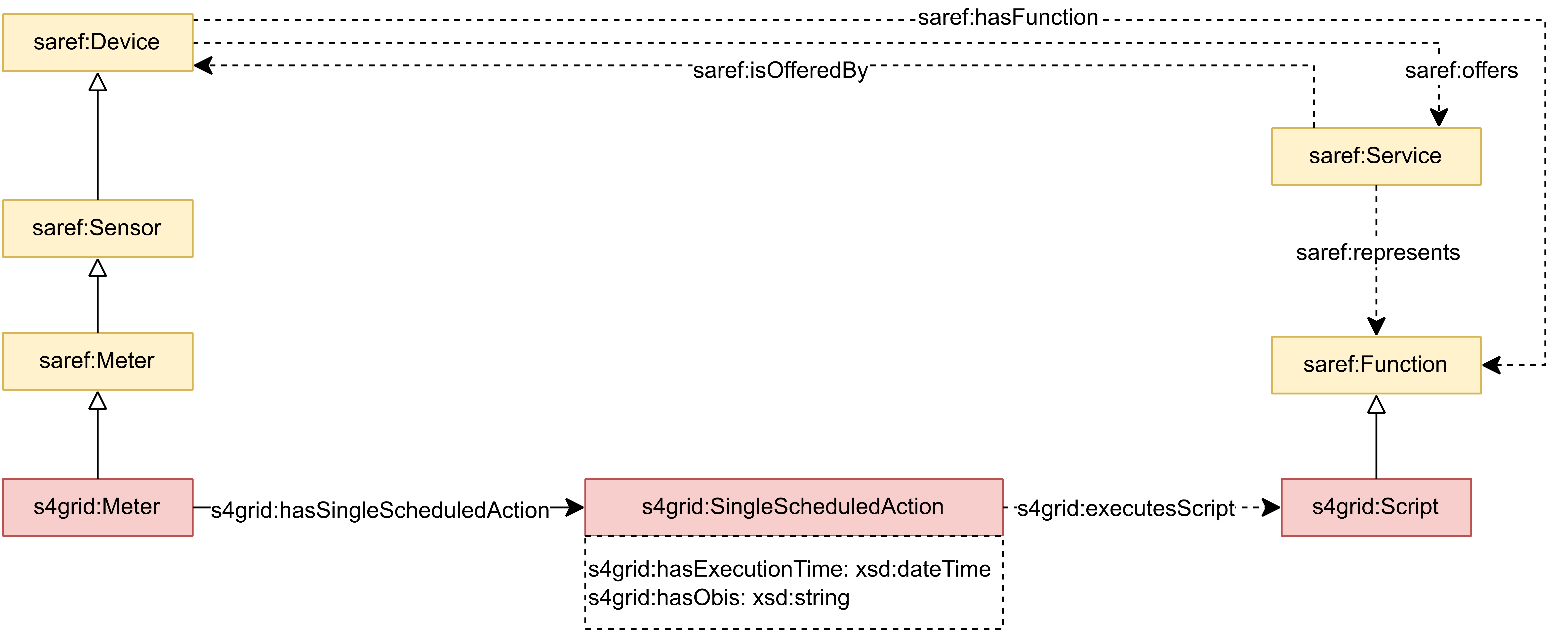
Activity Calendar
SAREF4GRID allows modelling the handling of various tariff structures in the meter by means of the s4grid:ActivityCalendar class, as presented in Figure 13. An activity calendar provides a list of scheduled actions, following the classical way of calendar-based schedules by defining seasons, weeks, etc. The representation of the meter activity calendar has been extracted from the IEC 62056-6-2:2017.
An activity calendar is active (s4grid:hasCalendarNameActive) if it is currently used for billing. Each active calendar has an associated passive calendar (s4grid:hasCalendarNamePassive) and its function is to allow to modify the parameters of the active calendar on a date prior to its activation date (s4grid:hasActivatePassiveCalendarTime). Activation date is the date from which the meter will use the passive calendar parameters and, therefore, they become active calendar parameters. An active calendar is compound by active seasons (s4grid:hasActiveSeasonProfile) and a passive calendar is compound by passive seasons (s4grid:hasPassiveSeasonProfile). Notice that there is no distinction between an active calendar and a passive calendar because together they represent an activity calendar and they share the same OBIS code.
A season profile (s4grid:SeasonProfile) represents periods of time during the year when billing conditions are always the same. A season is characterized by a start date (s4grid:hasSeasonStart) and seven day profiles (s4grid:hasDayProfile) to apply, which together represents a week (there is one day profile for each day of the week). A season finishes when the next season begins.
A day profile (s4grid:DayProfile) represents the discrimination of time along the day. Moreover, the seven day profiles together represents a period during the week when billing conditions are always the same. There are two day profiles: regular days (s4grid:RegularDayProfile) which represents not festive days, and special days (s4grid:SpecialDayProfile) which represents at which date there is a festivity, i.e. normal day behaves as a special day (s4grid:hasScpecialDayDate). A day profile is characterized by a day schedule (s4grid:hasDaySchedule).
A day schedule (s4grid:DaySchedule) defines the activation of certain scripts during the day, which can perform different activities inside the meter. For each day schedule, a list of scheduled actions is defined by a script to be executed (s4grid:executesScript) with the corresponding activation time (s4grid:hasStartTime).
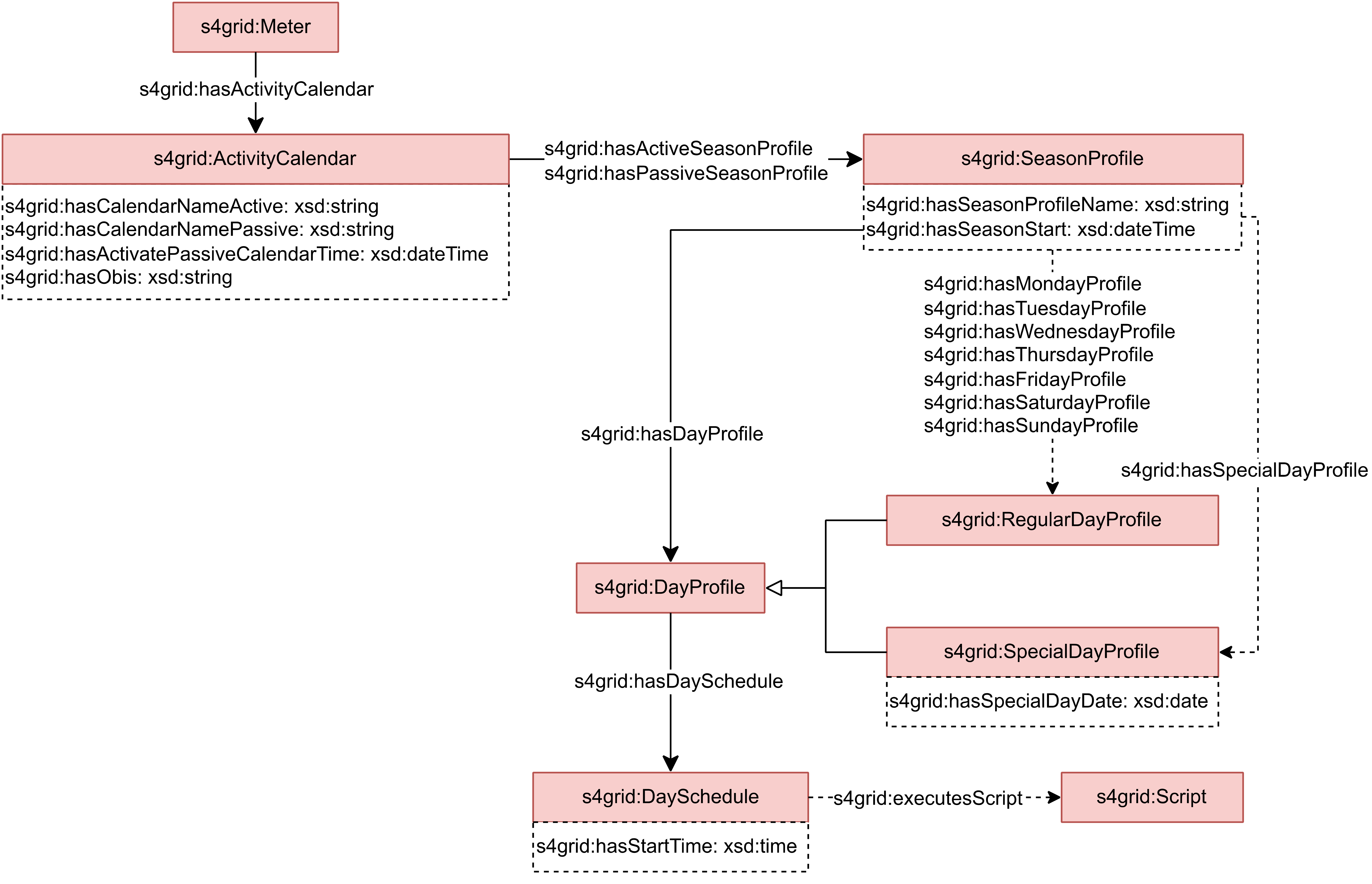
Power Line Properties
As it can be observed in Figure 14 and Figure 15, the modelling of measurements in the SAREF4GRID ontology mostly relies on the measurement model proposed in SAREF. In order to reduce duplication with SAREF documentation, the reader is referred to the SAREF specification for details about measurement modelling including here details only for the new concepts.
The DLMS/COSEM standard (IEC 62056) defines the measurements that a meter must take from a power line. It should be noted that in SAREF4GRID only the general properties are being defined. In order to use a more specific property it is neccesary to indicate the general property from which it comes from. The properties that are defined in SAREF4GRID, which are measured from a power line (s4grid:PowerLine), are depicted in Figure 14 and Figure 15.
SAREF4GRID categorises the main properties related to the enregy an power measurements of a power line (s4grid:EnergyPowerProperty): active energy measurements (s4grid:ActiveEnergy), reactive energy measurements (s4grid:ReactiveEnergy), apparent power measurements (s4grid:ApparentPower), demand register measurements (s4grid:DemandRegister), active power measurements (s4grid:ActivePower), reactive power measurements (s4grid:ReactivePower), current measurements (s4grid:Current), voltage measurements (s4grid:Voltage) and power factor related measurements (s4grid:PowerFactor).
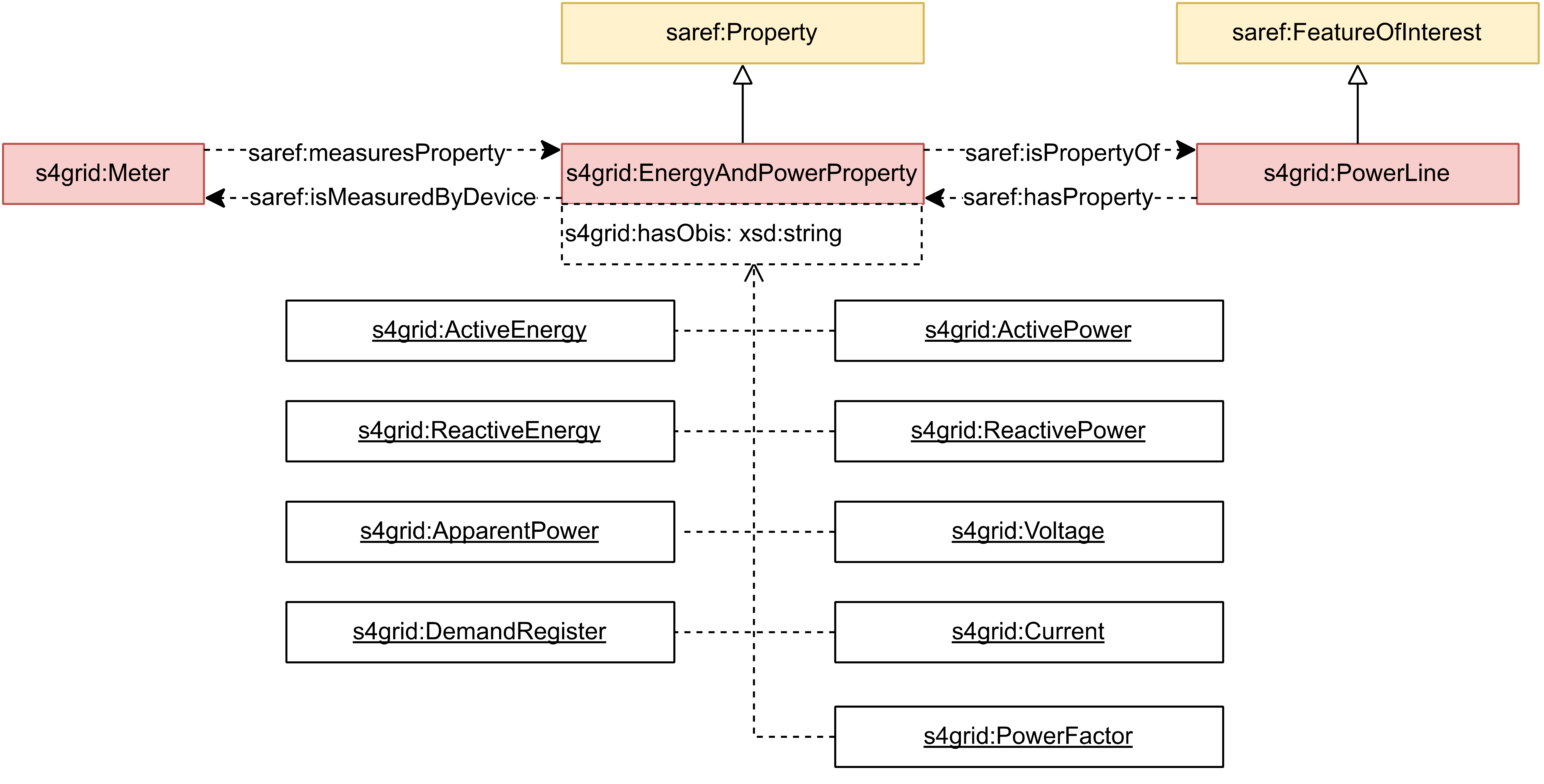
SAREF4GRID also categorises the main properties related to quality measurements of a power line (s4grid:QualityProperty):duration of voltage sags (s4grid:DurationVoltageSag), duration of voltage swells (s4grid:DurationVoltageSwell) and duration of long power failures (s4grid:DurationLongPowerFailure).

Profile Generic
SAREF4GRID allows modelling the storing, sorting and accessing of data groups or data series (i.e., capture objects in COSEM) in the meter by means of the s4grid:ProfileGeneric class, as presented in Figure 16. Capture objects are specific attributes or elements of (an) attribute(s) of COSEM objects. The capture objects are collected periodically or occasionally. The representation of the profile generic of a meter has been extracted from the IEC 62056-6-2:2017.
A profile generic is represented by the objects that it captures (s4grid:Clock, s4grid:PropertyValues and s4grid:Measurements). These capture objects are collected in each period defined in the s4grid:hasCapturePeriod property.
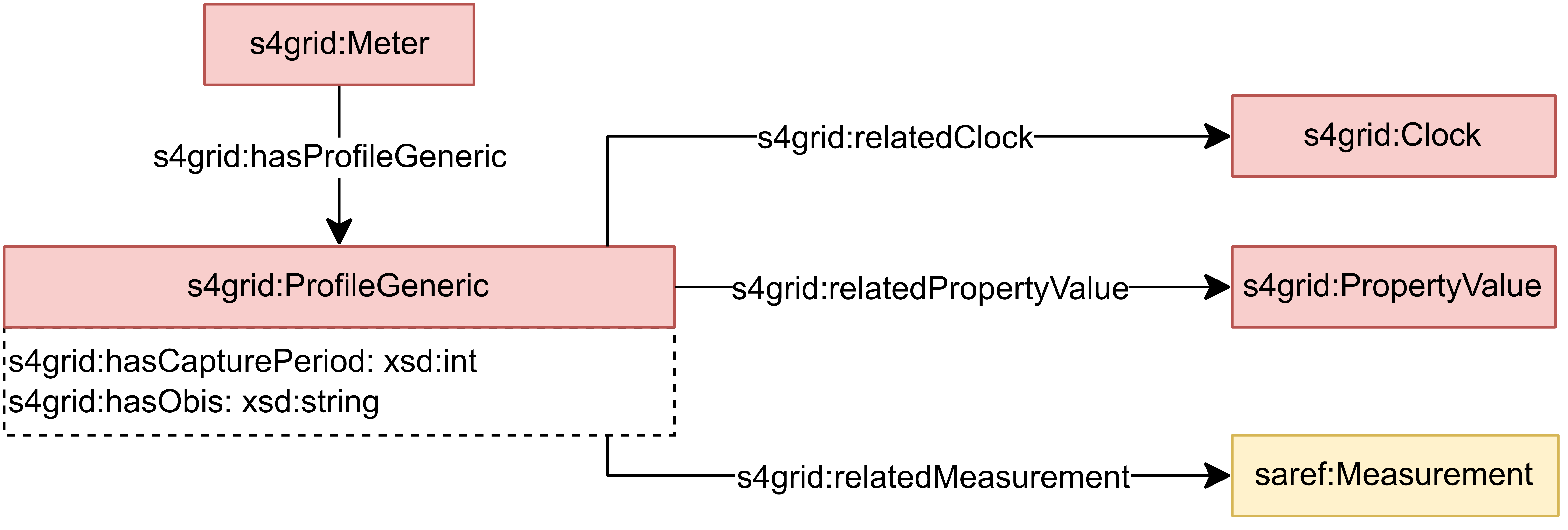
Get service
Figure 17 provides an overview of the modelling of get services (s4grid:GetService). A get service is performed through get operations (s4grid:GetOperation). The get operation modelling involves two main concepts, namely s4grid:CosemOperationInput and s4grid:GetOperationOutput. As can be seen in the figure, the modelling of get services totally relies on the service model proposed in ONEM2M. The representation of the inputs and outputs of a get service has been extracted from the IEC 62056-6-2:2017.
A get operation needs one input which represents what is going to be retrieved (the whole instance or just a property of the instance). Therefore, the input of a get operation can be either a class, the range of datatype property, or the range of an object property. The s4grid:CosemOperationInput class specifies the instance from which data is going to be retrieved by indicating the OBIS code (s4grid:obtainInputFromObis). If only the OBIS code is specified, it is understood that the whole instance is going to be retrieved. Moreover, the s4grid:GetOperationPropertyInput class specifies the object/datatype property of an instance from which data is going to be retrieved by indicating the OBIS code and the name of the object/datatype property (s4grid:obtaintInputForProperty). If the OBIS code and the property name are specified, it is understood that just the range of a property of the instance is going to be retrieved.
A get operation is going to generate one output which represents the type of what is going to be retrieved. The output of a get operation (s4grid:GetOperationOutput) can be either a class or a datatype. The s4grid:GetOperationDataOutput specifies that the output is going to be a datatype. In this case the type of the output is defined using the s4grid:hasOutputDataType property, indicating the name of the datatype. The s4grid:GetOperationObjectOutput class specifies that the output is going to be a class. In this case the type of the output is defined using the s4grid:hasOutputObjectType property, indicating the name of the class.
Additionally, in the case of a get service of a s4grid:ProfileGeneric class a selective access (s4grid:SelectiveAccess) can be specified. This indicates the range of entries to be retrieved (s4grid:EntryDescriptor) or the range of values (s4grid:RangeDescriptor) to be retrieved from a s4grid:ProfileGeneric class.

Set service
Figure 18 provides an overview of the modelling of set services (s4grid:SetService). A set service is performed through set operations (s4grid:SetOperation). The set operation modelling involves one main concept, namely s4grid:CosemOperationInput. As can be seen in the figure, the modelling of set services totally relies on the service model proposed in ONEM2M. In order to reduce duplication with the ONEM2M documentation, the reader is referred to the ONEM2M specification for details about service modelling. The representation of the inputs and outputs of a set service has been extracted from the IEC 62056-6-2:2017.
A set operation needs two inputs: the element that is going to be modified and the new data that is going to replace the old data. The element that is going to be modified is represented by a class meanwhile the new data is represented either by a class, the range of a datatype property, or the range of an object property (depending on if the whole instance is going to be modified or just a property). Therefore, the s4grid:CosemOperationInput class specifies the instance from which data is going to be modified by indicating the OBIS code (s4grid:obtainInputFromObis) and the new data is represented either by the s4grid:SetOperationObisInput, s4grid:SetOperationObjectInput or s4grid:SetOperationDataInput classes. The s4grid:SetOperationObisInput class indicates that the whole instance is going to be modified. In this case the type of the input is defined using the s4grid:hasInputObjectType property, indicating the name of the class expected to modify the instance. The s4grid:SetOperationObjectInput class indicates that just the range of an object property of the instance is going to be modified. In this case the type of the input is defined using the s4grid:obtainInputForProperty, which indicates the name of the object property whose range is going to be modified, and the s4grid:hasInputObjectType property, indicating the name of the class expected to modify the range of the object property. The s4grid:SetOperationDataInput class indicates that just the range of a datatype property of the instance is going to be modified. In this case the type of the input is defined using the s4grid:obtainInputForProperty, which indicates the name of the datatype property whose range is going to be modified, and the s4grid:hasInputDataType property, indicating the name of the datatype expected to modify the range of the datatype property.

Action service
Figure 19 provides an overview of the modelling of action services (s4grid:ActionService). An action service is performed through action operations (s4grid:ActionOperation). The action operation modelling involves one main concept, namely s4grid:CosemOperationInput. As can be seen in the figure, the modelling of action services totally relies on the service model proposed in ONEM2M. In order to reduce duplication with the ONEM2M documentation, the reader is referred to the ONEM2M specification for details about service modelling. The representation of the inputs and outputs of an action service has been extracted from the IEC 62056-6-2:2017.
An action operation needs two inputs: the element that is going to be affected by an action and the parameters necessary for the action to be executed. The element that is going to be affected by an action is represented by a class and the parameters are either represented by a class or a value. Therefore, the s4grid:CosemOperationInput class specifies the instance that is going to be affected by the action by indicating the OBIS code (s4grid:obtainInputFromObis) and the parameters are represented either by the s4grid:SimpleActionOperationInput or the s4grid:ComplexActionOperationInput. The s4grid:SimpleActionOperationInput class indicates that the parameter needed by the action to operate is simple (i.e., integer, string, etc.). In this case the value of the parameter is defined using the s4grid:hasActionValue property. The s4grid:ComplexActionOperationInput class indicates that the parameter needed by the action to operate is complex (i.e., structure). There are two cases of complex parameters: s4grid:PresetAdjustingTime class, which is needed by a s4grid:Clock to modify the time, and s4grid:SpecialDayEntry class, which is needed by an s4grid:ActivityCalendar to adding a new special day.
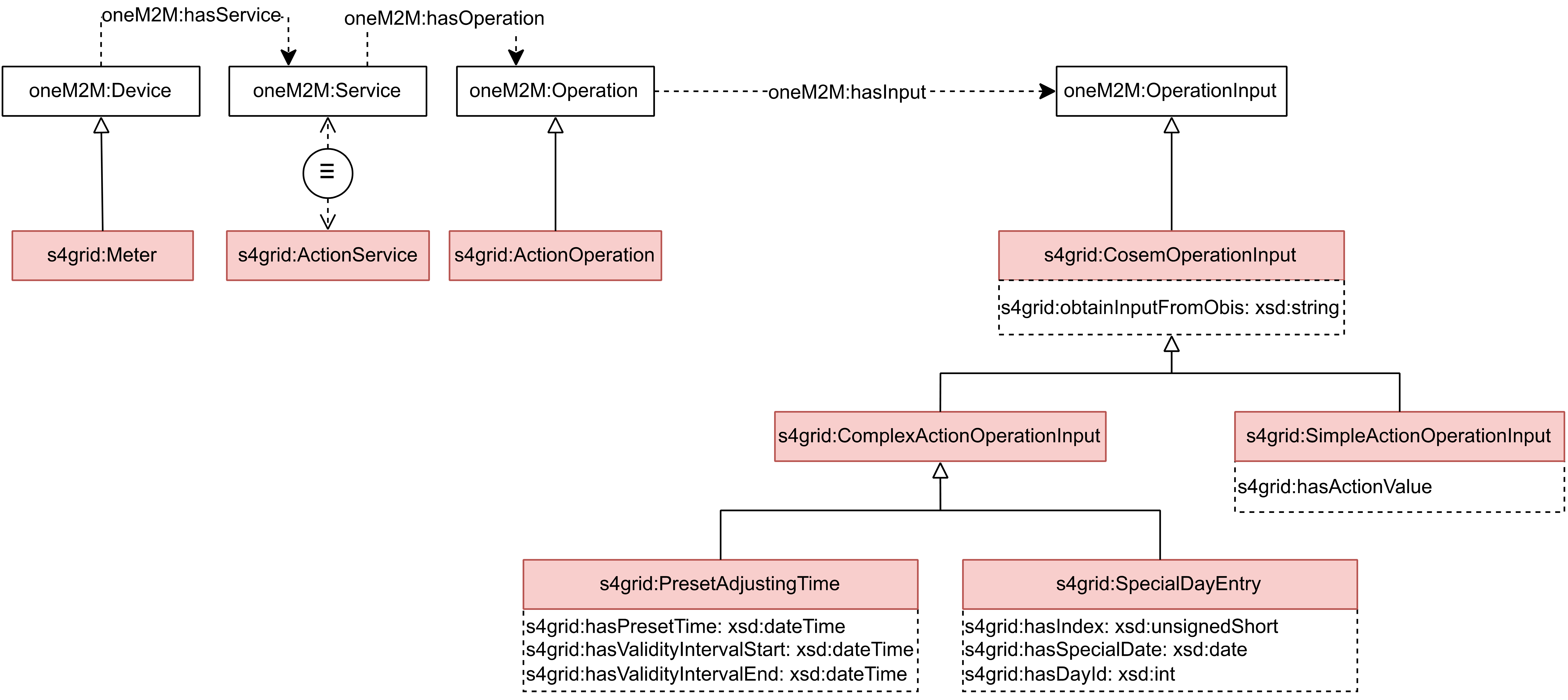
Examples
The example presented in Figure 20 depicts an electric grid meter (ex:Meter1234). It can be described by a set of meter properties (such as the one shown in the figure, ex:ScrollDisplayMode) that are identified by an OBIS code (s4grid:hasObis). Notice that some meter properties do not specify a unit of measure.
SAREF4GRID does not aim to provide an exhaustive definition of all the properties defined in the IEC 62056-6-2:2017. Instead, it defines a set of general properties (those shown in Figure 6, e.g., s4grid:ScreenDisplay in the figure) and specific properties can be related to these general properties using the SKOS ontology. Using SKOS more specific properties can be defined specifying from which general property they are derived (skos:narrower), and which properties belong to a general property (skos:broader).

The example presented in Figure 21 depicts an electric grid meter (ex:Meter1234). It can be described by a set of meter properties (e.g., ex:ActivePowerLimitContract1TariffPeriod1) which are identified by an OBIS code (s4grid:hasObis). The meter properties used to describe a meter are broader than the properties shown in Figure 6 (e.g., s4grid:PowerLimit). Notice that some meter properties specify a unit of measure (e.g., om:watt).

Unlike other SAREF extensions, a meter firmware is not defined by a datatype property. The example presented in Figure 22 depicts a meter firmware (e.g., ex:ActivePLCFirmware) which is represented by an OBIS code (s4grid:hasObis).

Figure 23 contains an example of a network interface (ex:MacAddress1234) defined for a meter. Moreover, the network interface is represented by an OBIS code (s4grid:hasObis).

Figure 24 contains an example of a meter clock (ex:Clock1234). Moreover, the clock interface is represented by an OBIS code (s4grid:hasObis). Notice that the clock is not only represented by a time (s4grid:hasTime), but is also represented by the time zone in which it is located and how the time is changed.
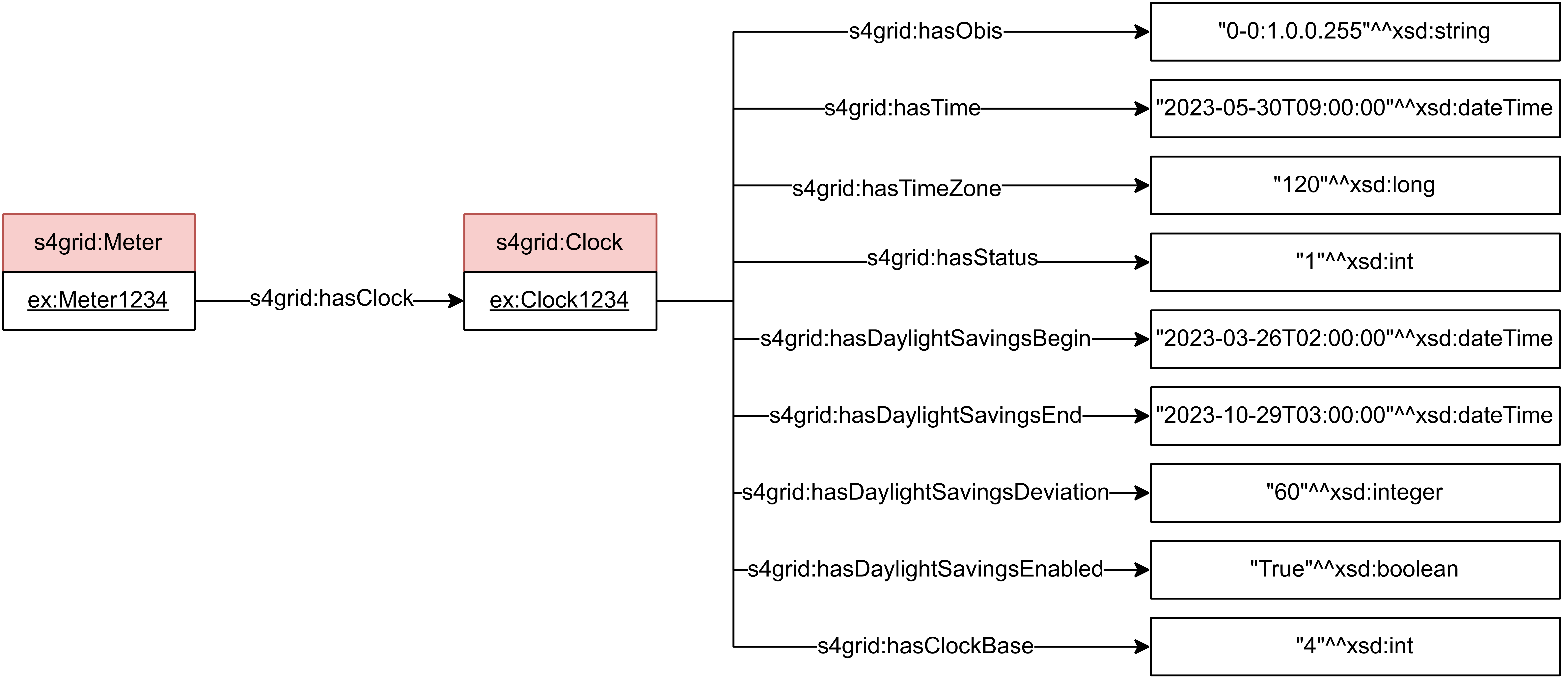
Figure 25 contains an example of a meter brekaer state (ex:CurrentConnectivityState). In this example, it is represented that the meter is physical connected (s4grid:hasOutputState), internal connected (s4grid:hasControlState) and it can be be remotely, manually and locally disconnected (s4grid:hasControlMode). Moreover, the breaker state is represented by an OBIS code (s4grid:hasObis).

Figure 26 contains an example of how scripts (ex:ConnectionScript and ex:DisconnectionScript) are stored in the meter. A script table (ex:DisconnectScriptTable) is needed in order to represents where the scripts are located. Moreover, a single schedule action (ex:DisconnectControlScheduler) is used to represent that a script is going to be executed in a determined date. Moreover, the script table and single scheduled action are represented by an OBIS code (s4grid:hasObis).
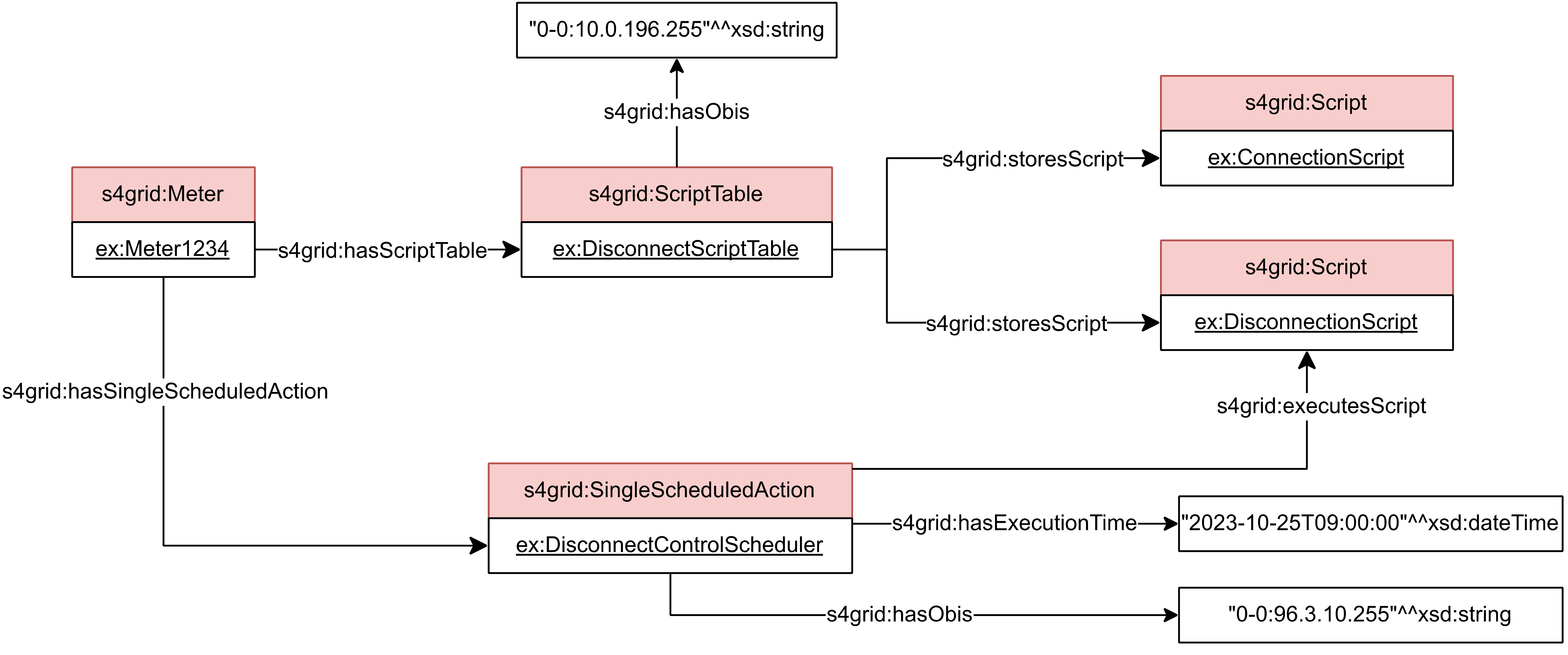
Figure 27 contains an example of how an activity calendar (ex:ActivityCalendarContract1-1234) is represented in a meter. This activity calendar is represented by an active season (ex:SeasonActive1) which is described by the date at which it starts and two regular day profiles: one that describes working days (ex:WeekDay) and other that describes weekend days (ex:WeekendDay). Each day profile is represented by when a billing period starts each day (ex:WeekDayTariffPeriod1 and ex:WeekendDayTariffPeriod1) and what scripts need to execute to make the billing (ex:ResetBillingPeriod1 and ex:ResetBillingPeriod2). Additionally, a special day profile (ex:SpecialTariffPeriod1) defines which days are special (e.g., festive) and, therefore, another tariffication is going to be applied. Moreover, the activity calendar is represented by an OBIS code (s4grid:hasObis). Notice that just the active calendar is represented (e.g., the passive calendar associated to the active calendar is not represented) in order to simplify the example.
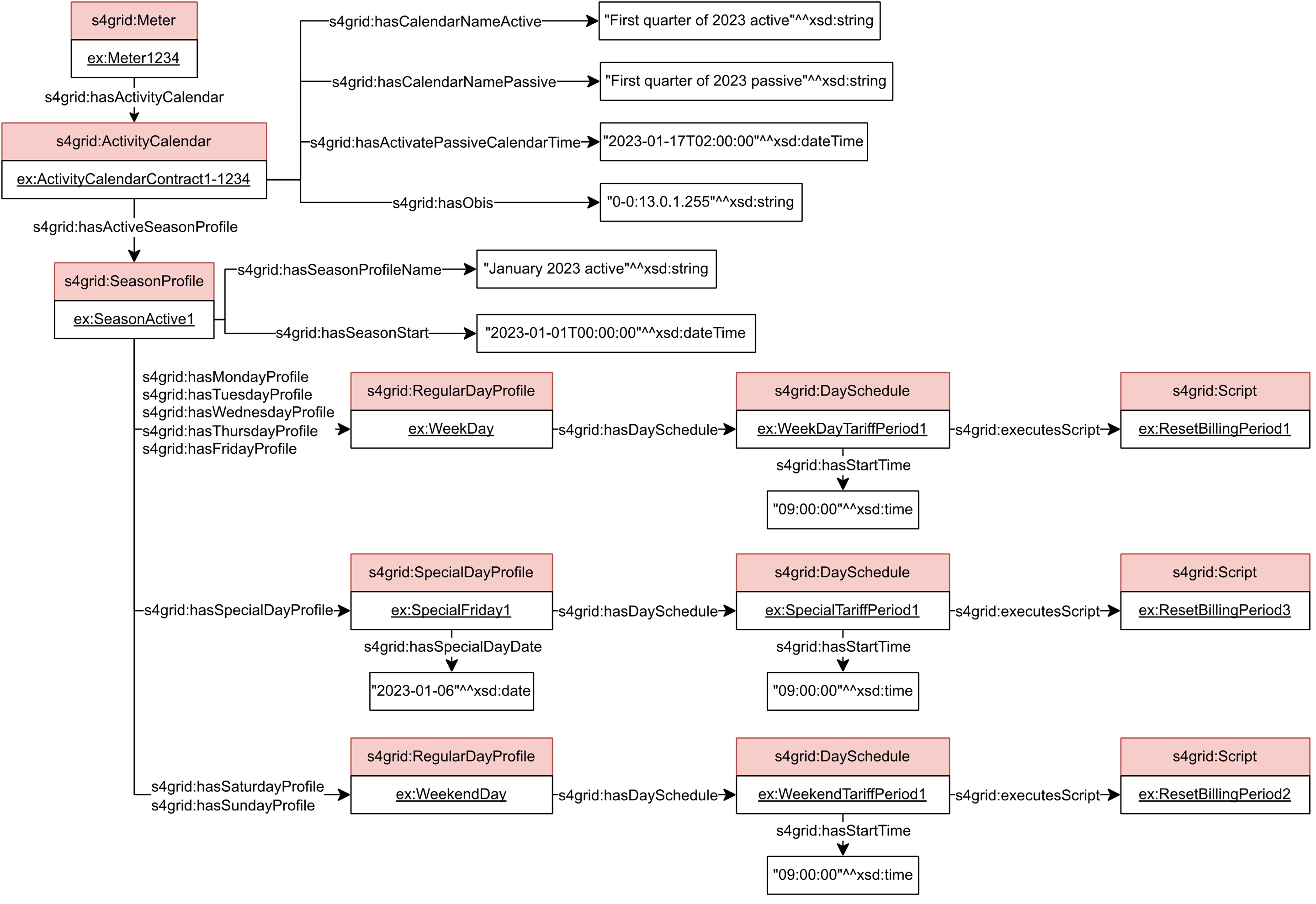
One of the main functions of electric grid meters is to take measures from a power line in order to control what is happening in the electric grid. Figure 28 presents an example of a power line measurement (ex:TotalIncrementalActiveEnergyImportMeasurement123) for a power line property (ex:TotalIncrementalActiveEnergyImport) that is identified by an OBIS code (s4grid:hasObis).
As with meter properties, SAREF4GRID does not aim to provide an exhaustive definition of all the properties defined in the IEC 62056-6-2:2017. Instead, it defines a set of general properties (those shown in Figure 14 and Figure 15, e.g., s4grid:ActiveEnergy in the figure) and specific properties can be related to these general properties using the SKOS ontology. Using SKOS more specific properties can be defined specifying from which general property they are derived (skos:narrower), and which properties belong to a general property (skos:broader).
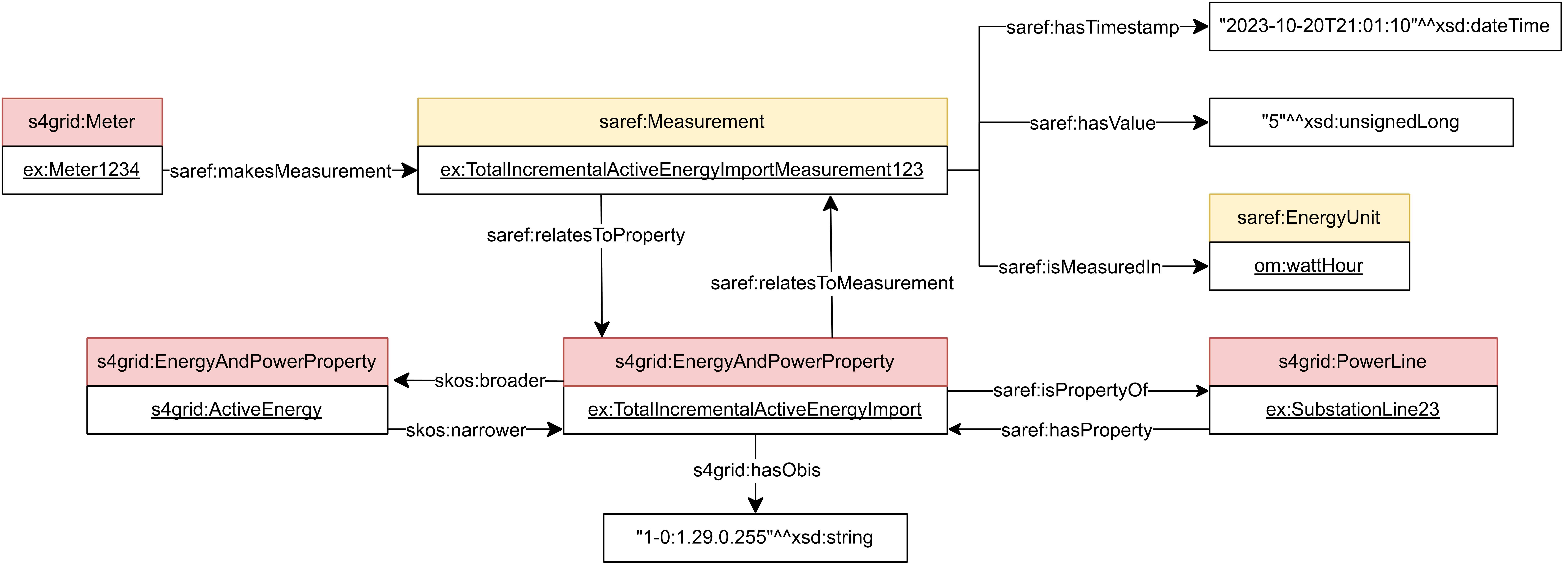
Figure 29 presents another example of a power line measurement (ex:MaximumDemandRegisterImportC1TP1Measurement136) for a power line property (ex:MaximumDemandRegisterImportC1TP1) which are identified by an OBIS code (s4grid:hasObis). The power line properties are broader than the properties shown in Figure 14 and Figure 15 (e.g., s4grid:DemandRegister).
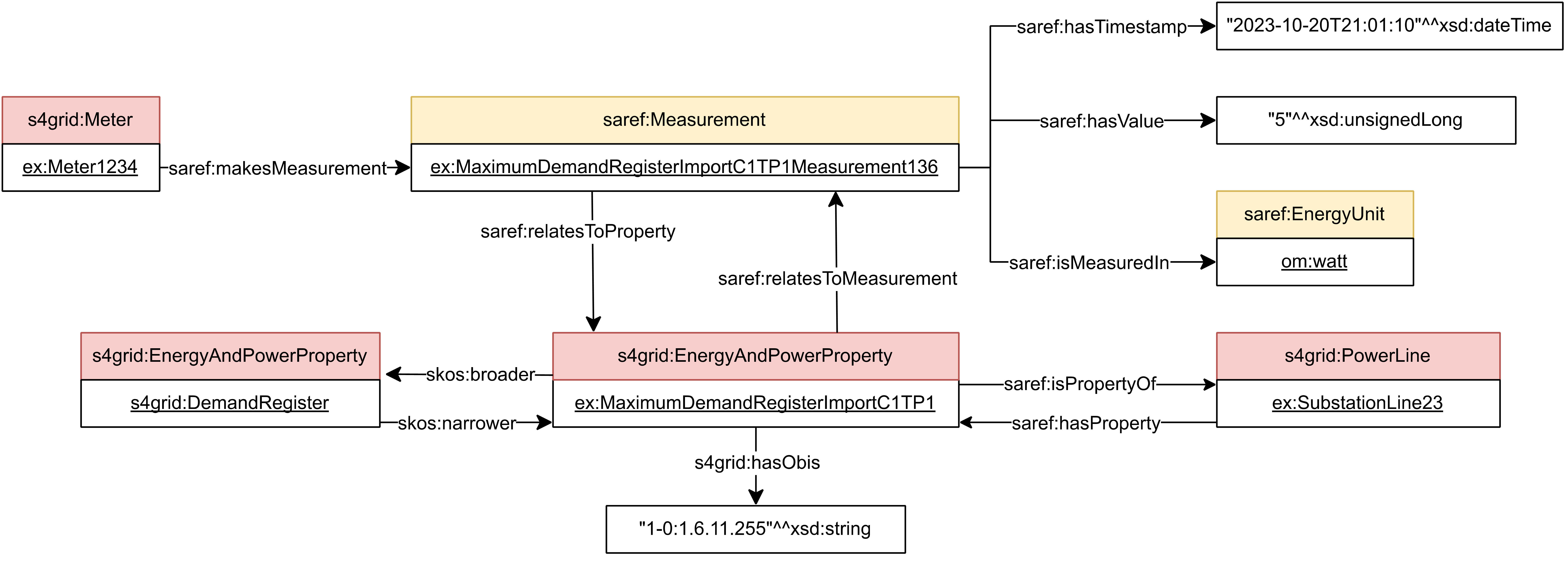
Different profile generics can be generated in order to access data groups which are stored in an electric grid meter. Figure 30 presents an example of a profile generic (ex:IncrementalLoadProfile1234) whose objective is to store the incremental energy values that a meter measures (ex:Measurement1 to ex:Measurement6) each hour. Additionally, the profile generic stores the clock (ex:Clock1234) to indicate the time at which the profile generic captures elements, and the AMR status (ex:PropertyValue1) that the meter stores. Moreover, the profile generic is represented by an OBIS code (s4grid:hasObis).
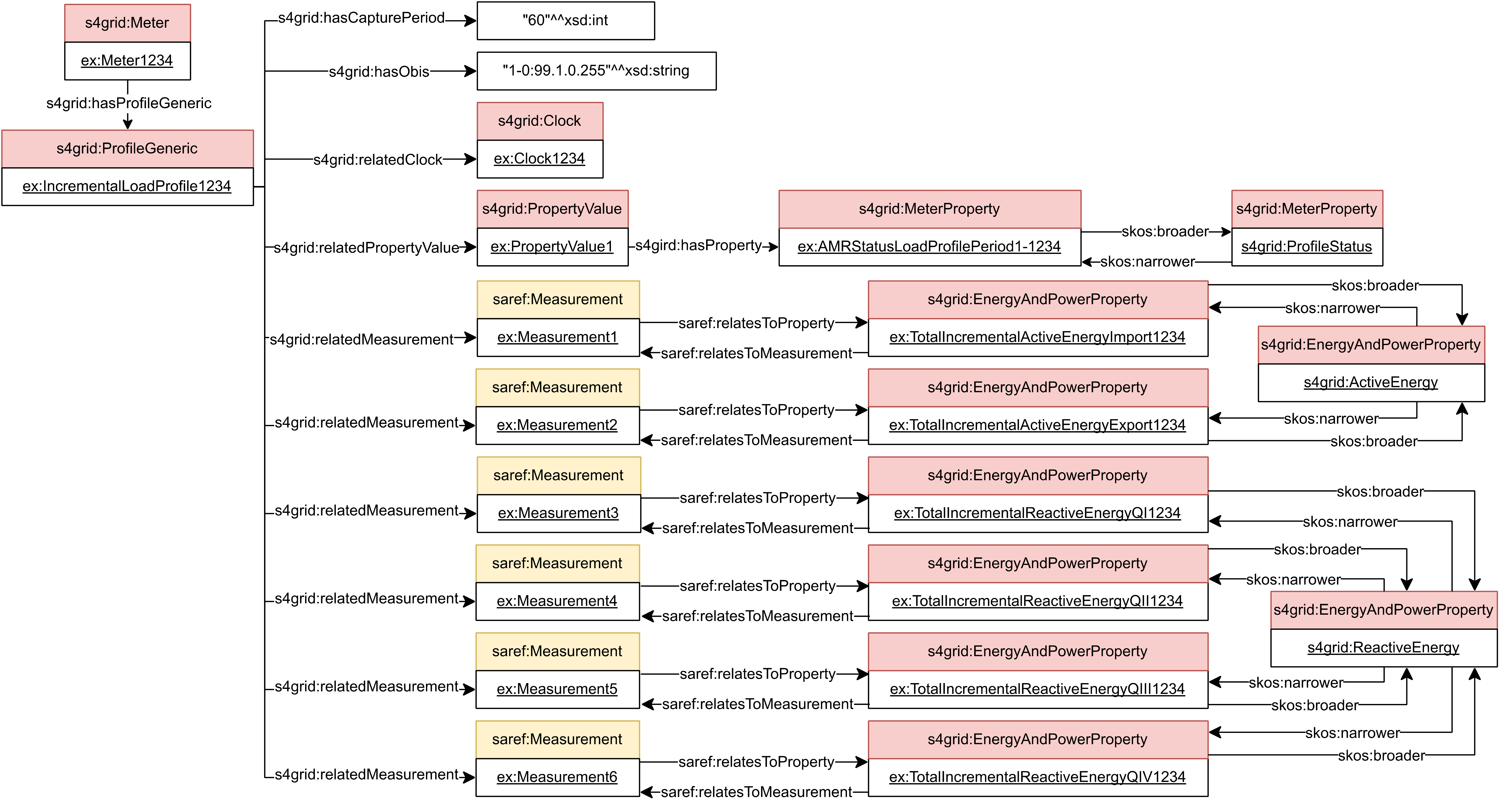
Each element that a meter stores can be obtained through a get service. Figure 31 presents an example of how it is specified that a COSEM element is going to be obtained. A get service (ex:GetServiceIncrementalLoadProfile) is executed through a get operation (ex:GetOperationIncrementalLoadProfile). This operation indicates the desired input (ex:OperationInputIncrementalLoadProfile), which in this case it specifies the element from which data is going to be retrieved, and the desired output (ex:OutputIncrementalLoadProfile), which in this case specifies the data structure that is going to be given.
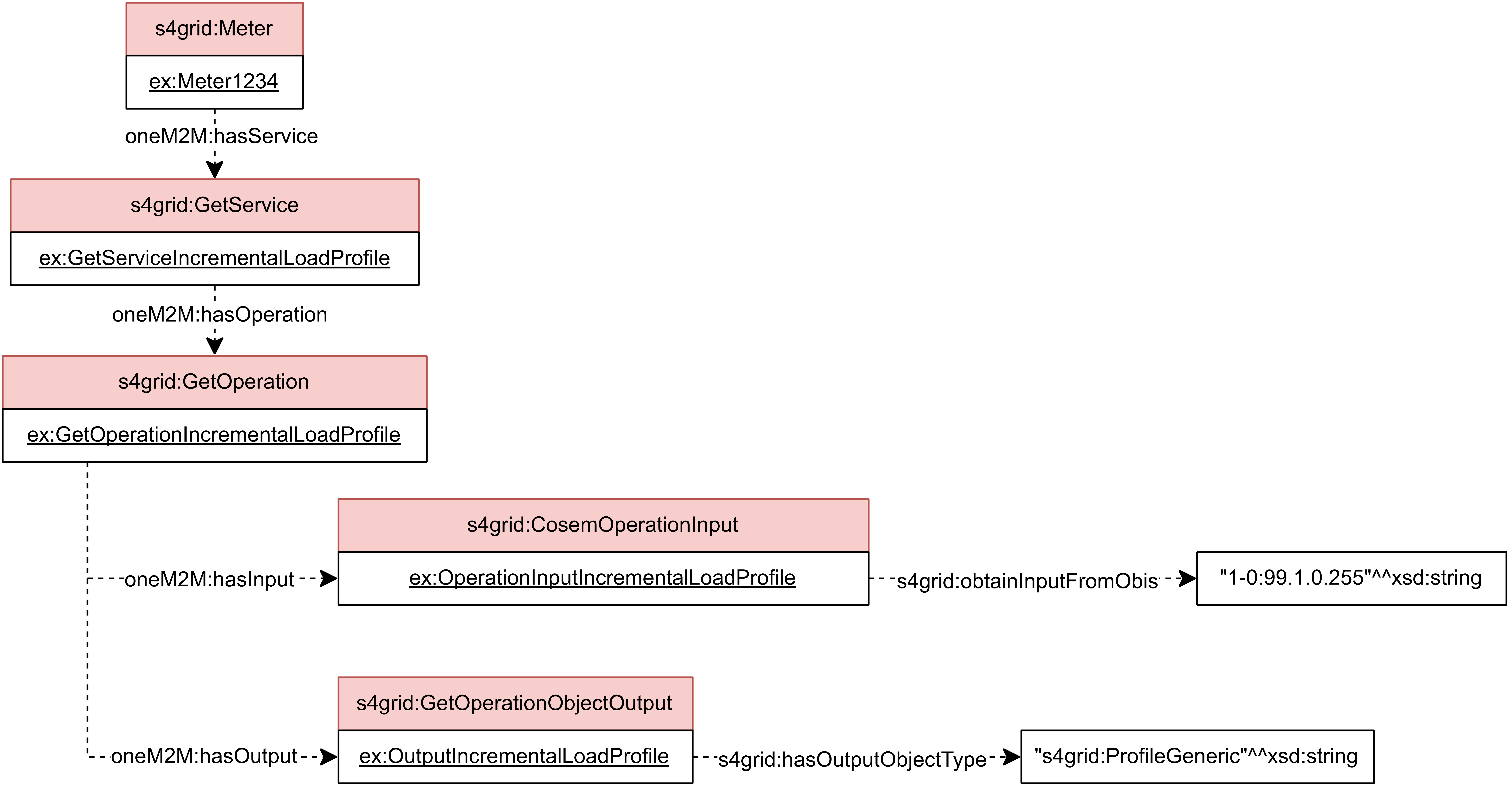
Figure 32 presents an example of how it is specified that an attribute of a COSEM element is going to be obtained. Notice that in this example, the attribute corresponds to a datatype property of the SAREF4GRID ontology. A get service (ex:GetServiceCapturePeriodIncrementalLoadProfile) is executed through a get operation (ex:GetOperationCapturePeriodIncrementalLoadProfile). This operation indicates the desired input (ex:OperationInputCapturePeriodIncrementalLoadProfile), which in this case specifies the datatype property of the element from which data is going to be retrieved, and the desired output (ex:OutputCapturePeriodIncrementalLoadProfile), which in this case specifies the datatype that is going to be given.
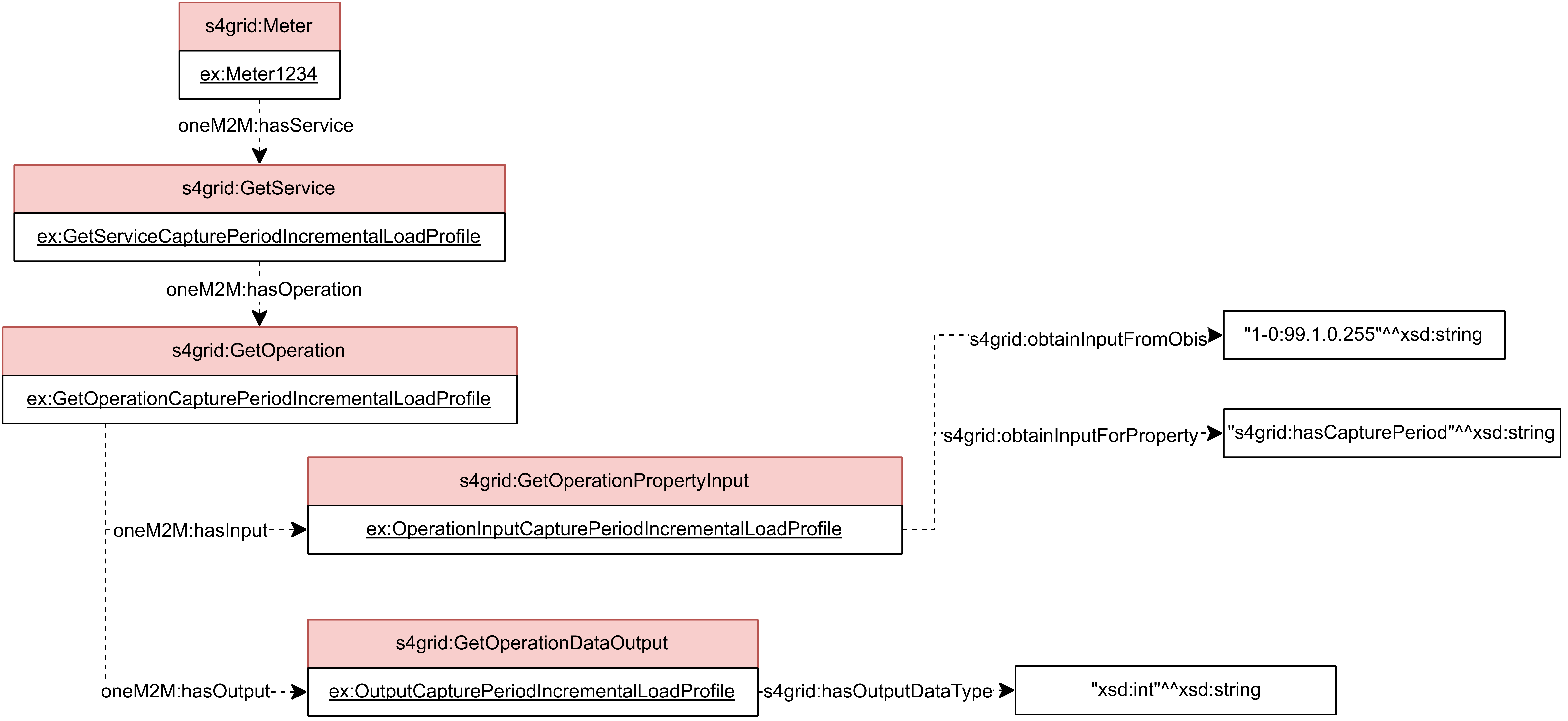
Figure 33 presents an example of how it is specified that an attribute of a COSEM element is going to be obtained. Notice that in this example, the attribute corresponds to an object property of the SAREF4GRID ontology. A get service (ex:GetServiceDisconnectionScript) is executed through a get operation (ex:GetOperationDisconnectionScript). This operation indicates the desired input (ex:OperationInputDisconnectionScript), which in this case specifies the object property of the element from which data is going to be retrieved, and the desired output (ex:OutputDisconnectionScript), which in this case specifies the data structure that is going to be given.
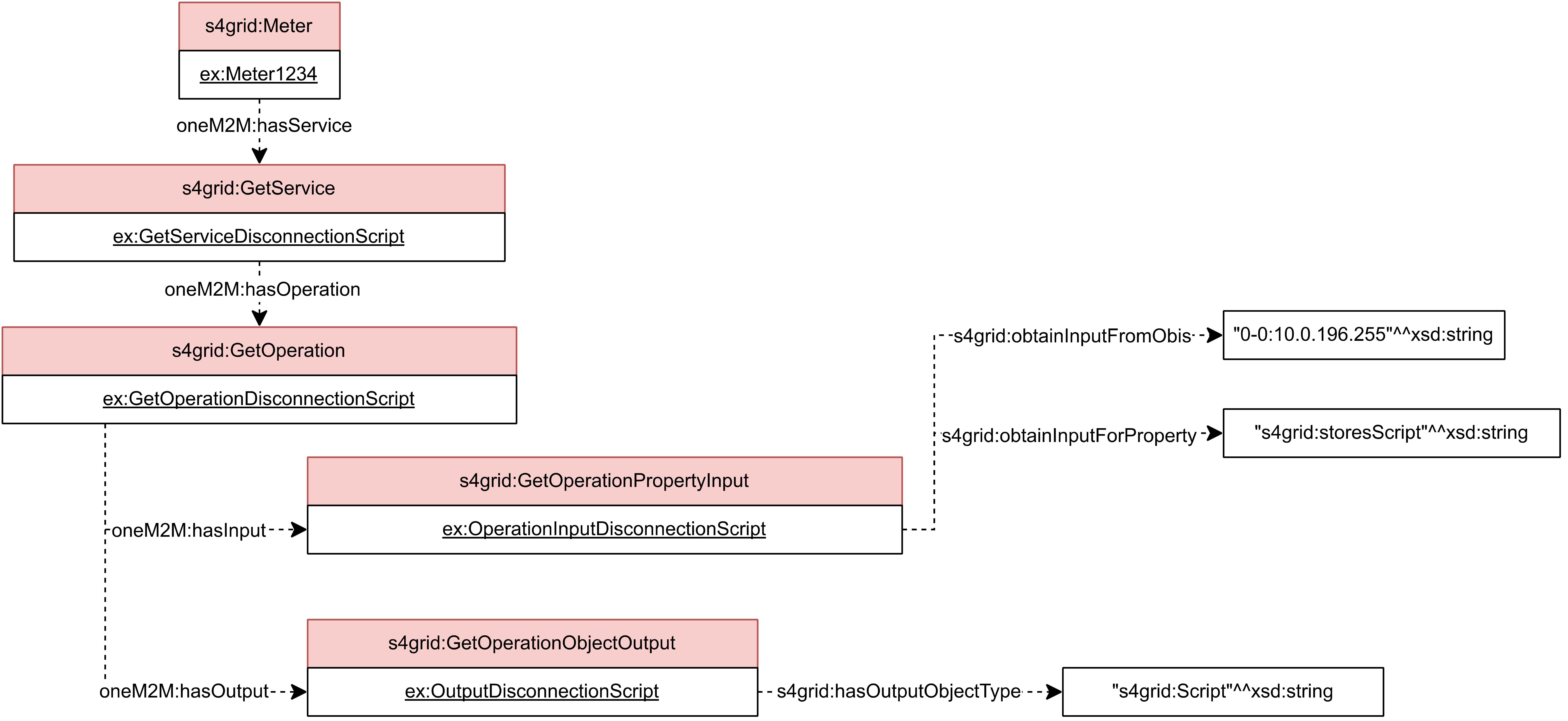
Property-related services in get operations usually refer to the entire property. However, in the case of certain properties, selective access to only part of the property may be provided. Figure 34 presents an example of how it is specified that a range of values are going to be retrieved from a profile generic. A selective range get service (ex:GetServiceIncrementalLoadProfileRange) is executed through a get operation (ex: GetOperationIncrementalLoadProfileRange). This operation indicates the desired input (ex:OperationInputIncrementalLoadProfileRange), which in this case specifies the element from which data is going to be retrieved, and the desired output (ex:OutputIncrementalLoadProfileRange), which in this case specifies the data structure that is going to be given. Additionally, a selective access with a range descriptor (ex:RangeDescriptor1) indicates that just the entries whose value is between 1 and 10 are going to be retrieved.
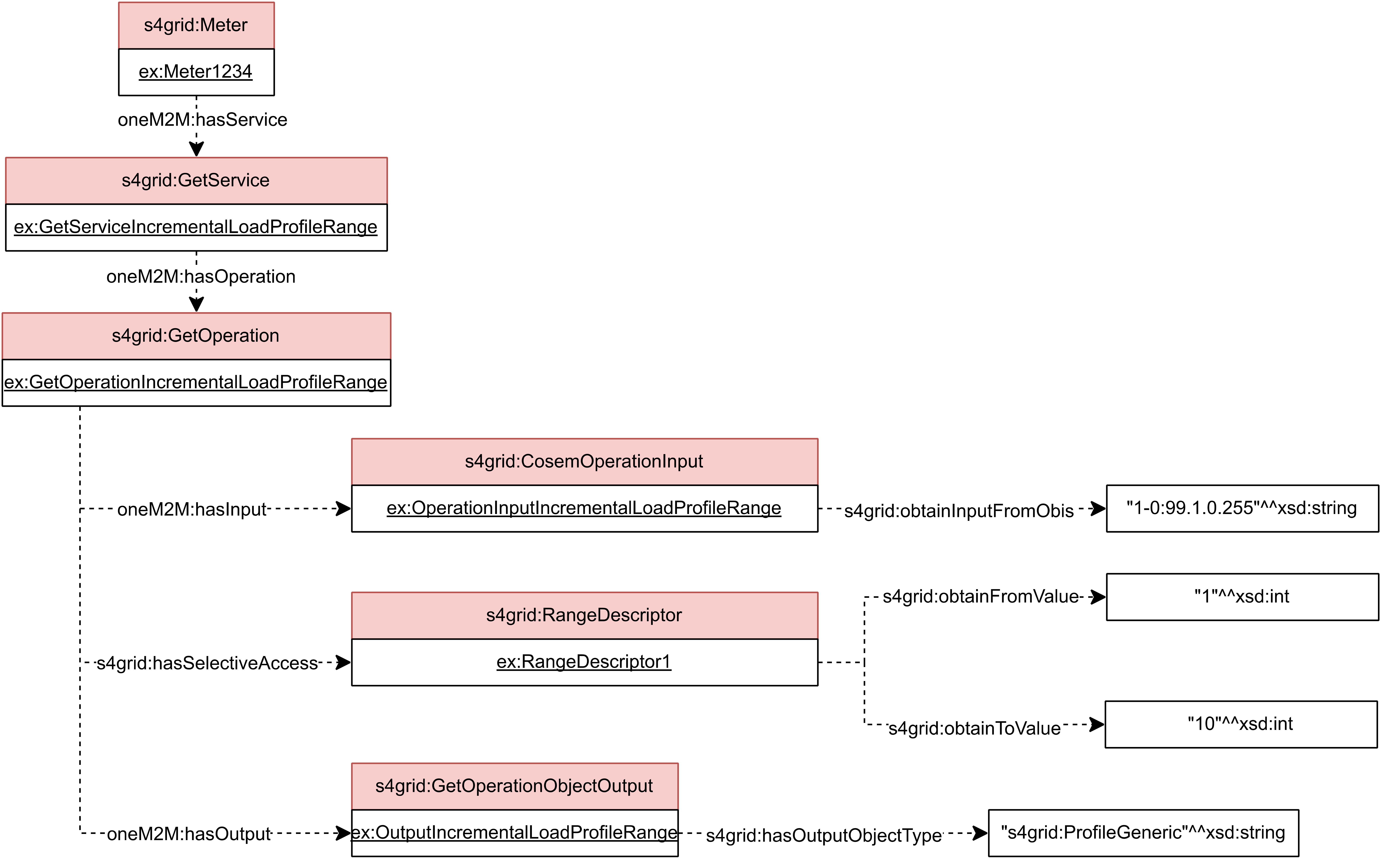
Figure 35 presents an example of how it is specified that a range of entries are going to be retrieved from a profile generic. A selective entry get service (ex:GetServiceIncrementalLoadProfileEntry) is executed through a get operation (ex: GetOperationIncrementalLoadProfileEntry). This operation indicates the desired input (ex:OperationInputIncrementalLoadProfileEntry), which in this case specifies the element from which data is going to be retrieved, and the desired output (ex:OutputIncrementalLoadProfileEntry), which in this case specifies the data structure that is going to be given. Additionally, a selective access with an entry descriptor (ex:EntryDescriptor1) indicates that just the top 10 entries are going to be retrieved.
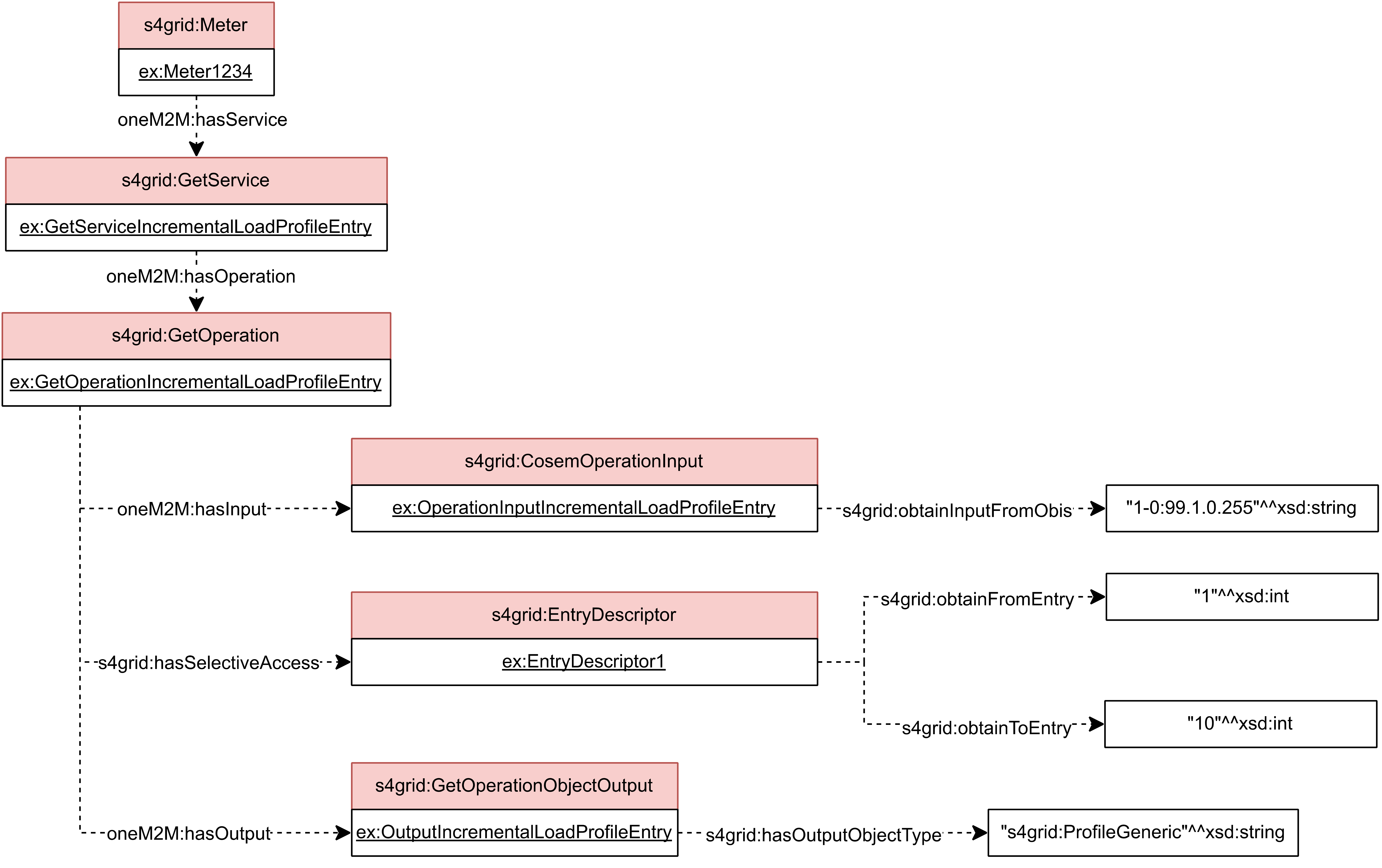
Each element that a meter stores can be modified through a set service. Figure 36 presents an example of how it is specified that a COSEM element is going to be modified. A set service (ex:SetMulticastCommunicationIdentifier) is executed through a set operation (ex:SetOperationMulticastCommunicationIdentifier). This operation indicates the desired input (ex:InputMulticastCommunicationIdentifier), which in this case specifies the element from which data is going to be modified and the data structure that is going to replace the previous data.
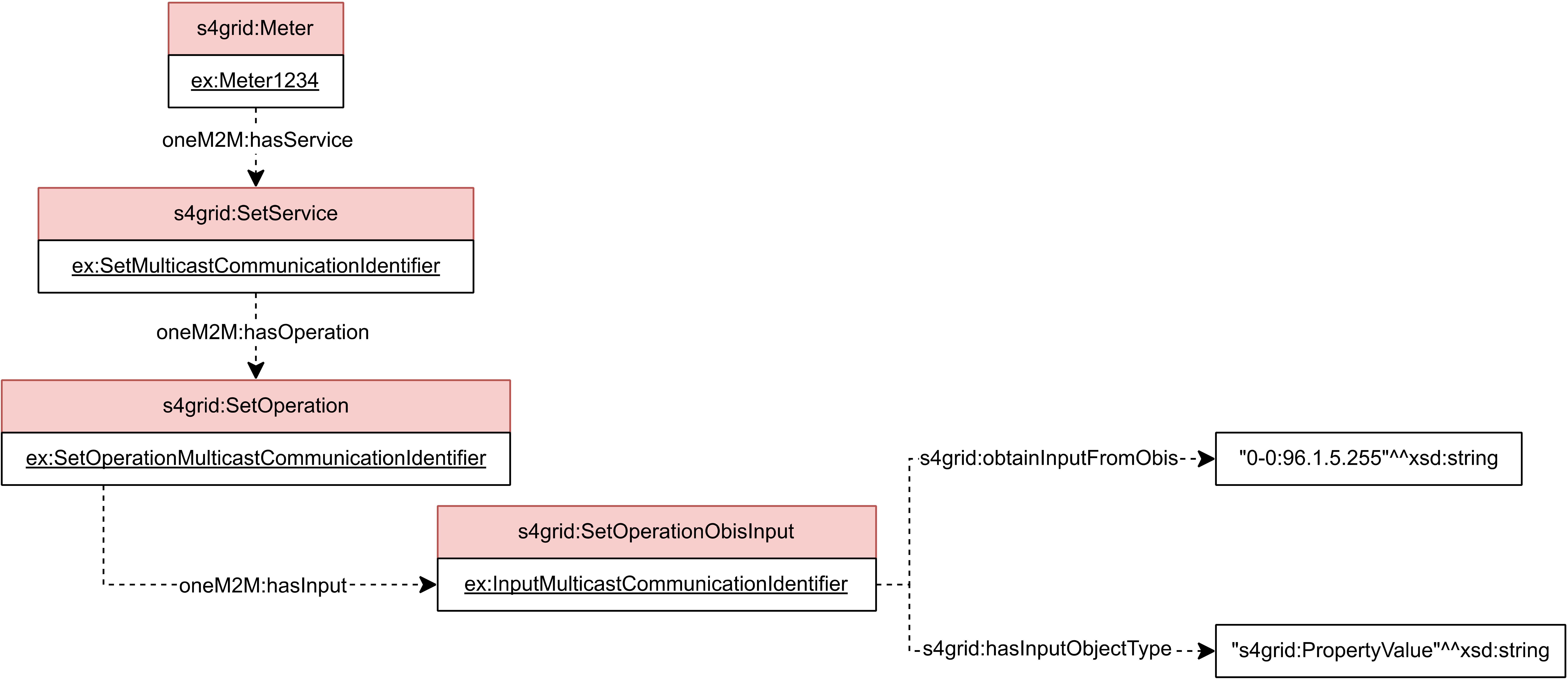
Figure 37 presents an example of how it is specified that an attribute of a COSEM element is going to be modified. Notice that in this example, the attribute corresponds to a datatype property of the SAREF4GRID ontology. A set service (ex:SetServiceCapturePeriodIncrementalLoadProfile) is executed through a set operation (ex:SetOperationCapturePeriodIncrementalLoadProfile). This operation indicates the desired input (ex:InputICapturePeriodIncrementalLoadProfile), which in this case specifies the datatype property of the element from which data is going to be modified and the data type that is going to replace the previous data.
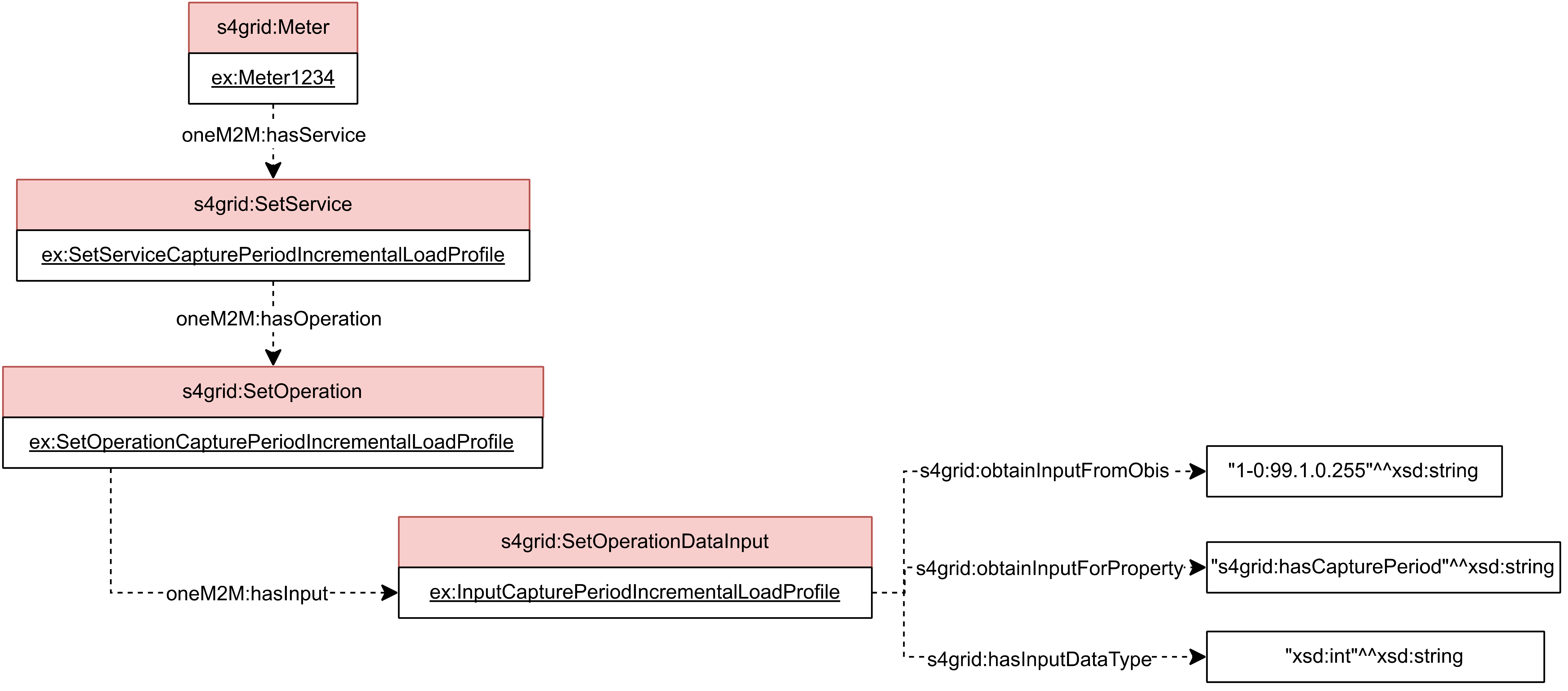
Figure 38 presents an example of how it is specified that an attribute of a COSEM element is going to be modified. Notice that in this example, the attribute corresponds to an object property of the SAREF4GRID ontology. A set service (ex:SetServiceDisconnectionScript) is executed through a set operation (ex:SetOperationDisconnectionScript). This operation indicates the desired input (ex:InputIDisconnectionScript), which in this case specifies the object property of the element from which data is going to be modified and the data structure that is going to replace the previous data.
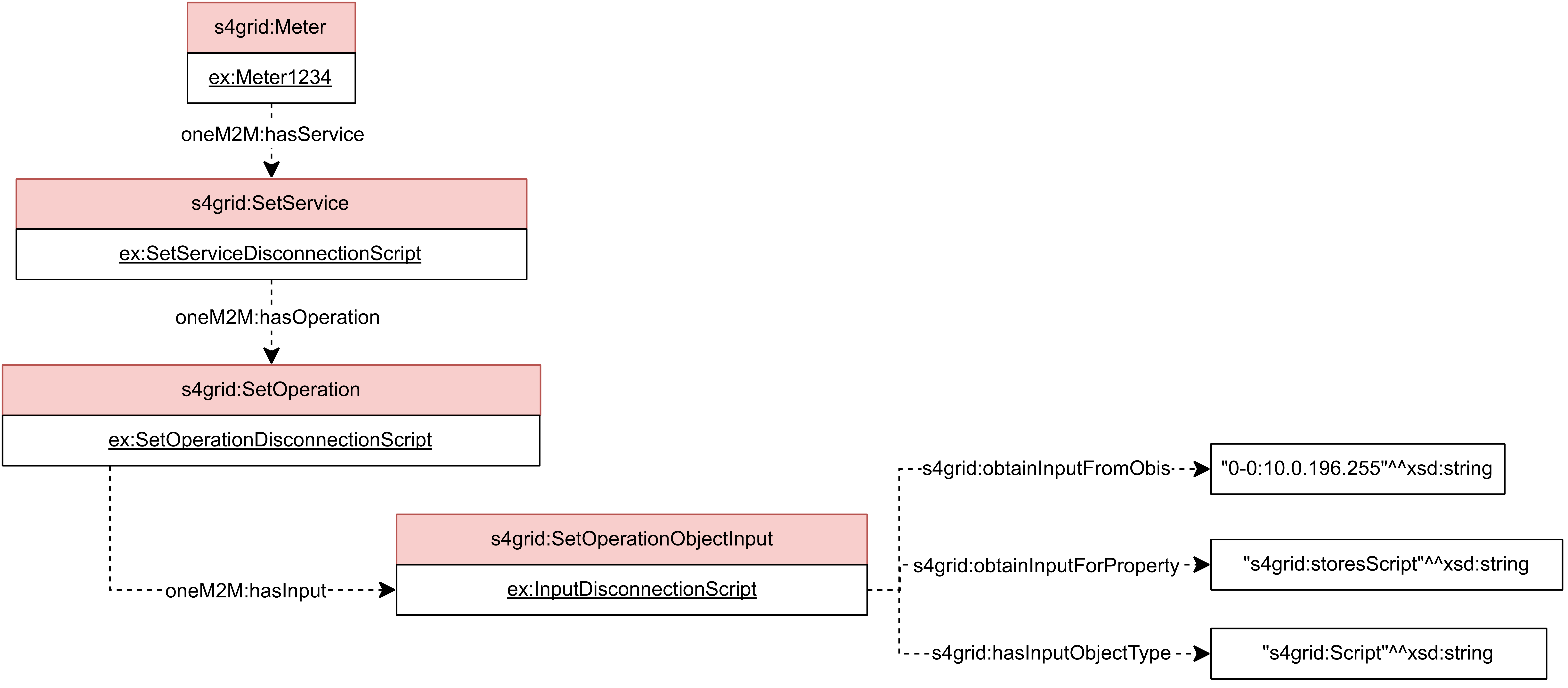
Each element that a meter stores can be affected through an action service. Figure 39 presents an example of how it is specified that a COSEM element is going to be affected by an action. Notice that in this example the input parameter needed to execute the action is simple (e.g., integer, string, etc.). An action service (ex:ResetServiceRegister) is executed through an action operation (ex:ResetServiceOperation). This operation indicates the desired input (ex:ResetServiceOperationInput), which in this case specifies the element that is going to be affected by the action and the value of the parameter needed by the action.
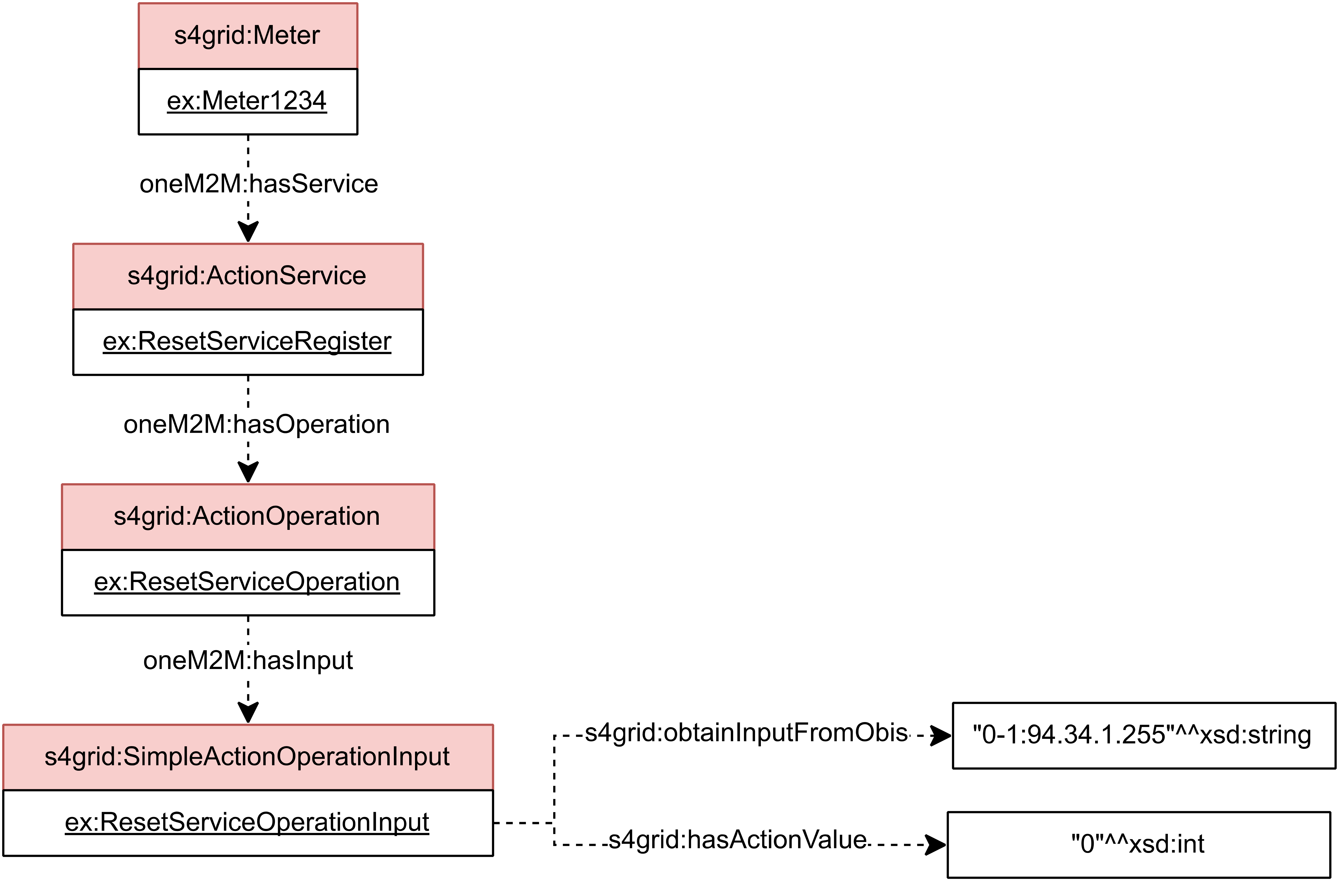
Figure 40 presents an example of how it is specified that a COSEM element is going to be affected by an action. Notice that in this example the input parameter needed to execute the action is a structure. An action service (ex:PresetAdjustingTimeServiceClock) is executed through an action operation (ex:PresetAdjustingTimeOperation). This operation indicates the desired input (ex:PresetAdjustingTime1), which in this case specifies the element that is going to be affected by the action and the values of the parameter structure needed by the action.
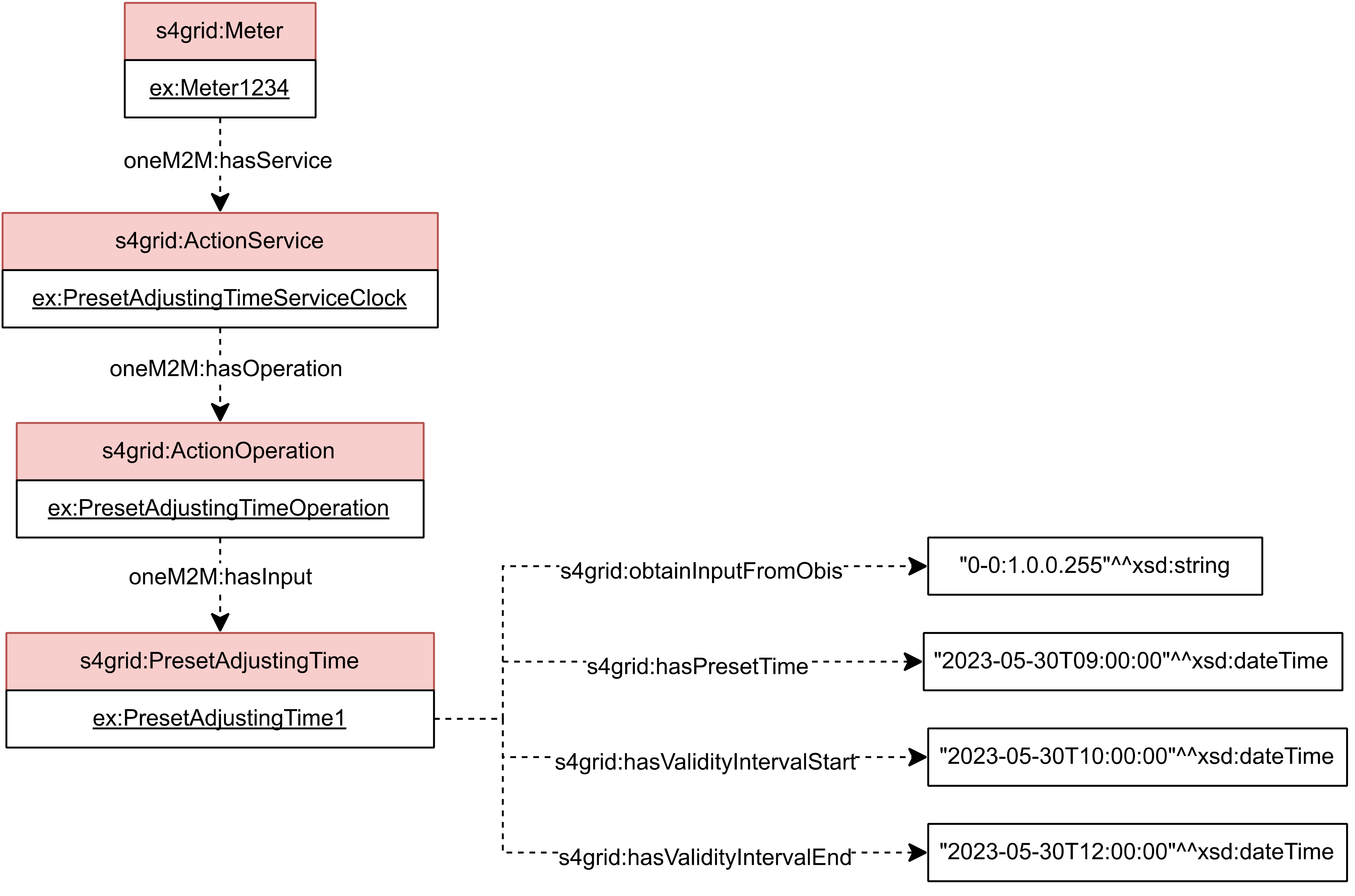
Figure 41 presents an example of how it is specified that a COSEM element is going to be affected by an action. Notice that in this example the input parameter needed to execute the action is a structure. An action service (ex:SpecialDayEntryServiceActivityCalendar) is executed through an action operation (ex:SpecialDayEntryOperation). This operation indicates the desired input (ex:SpecialDayEntry1), which in this case specifies the element that is going to be affected by the action and the values of the parameter structure needed by the action.
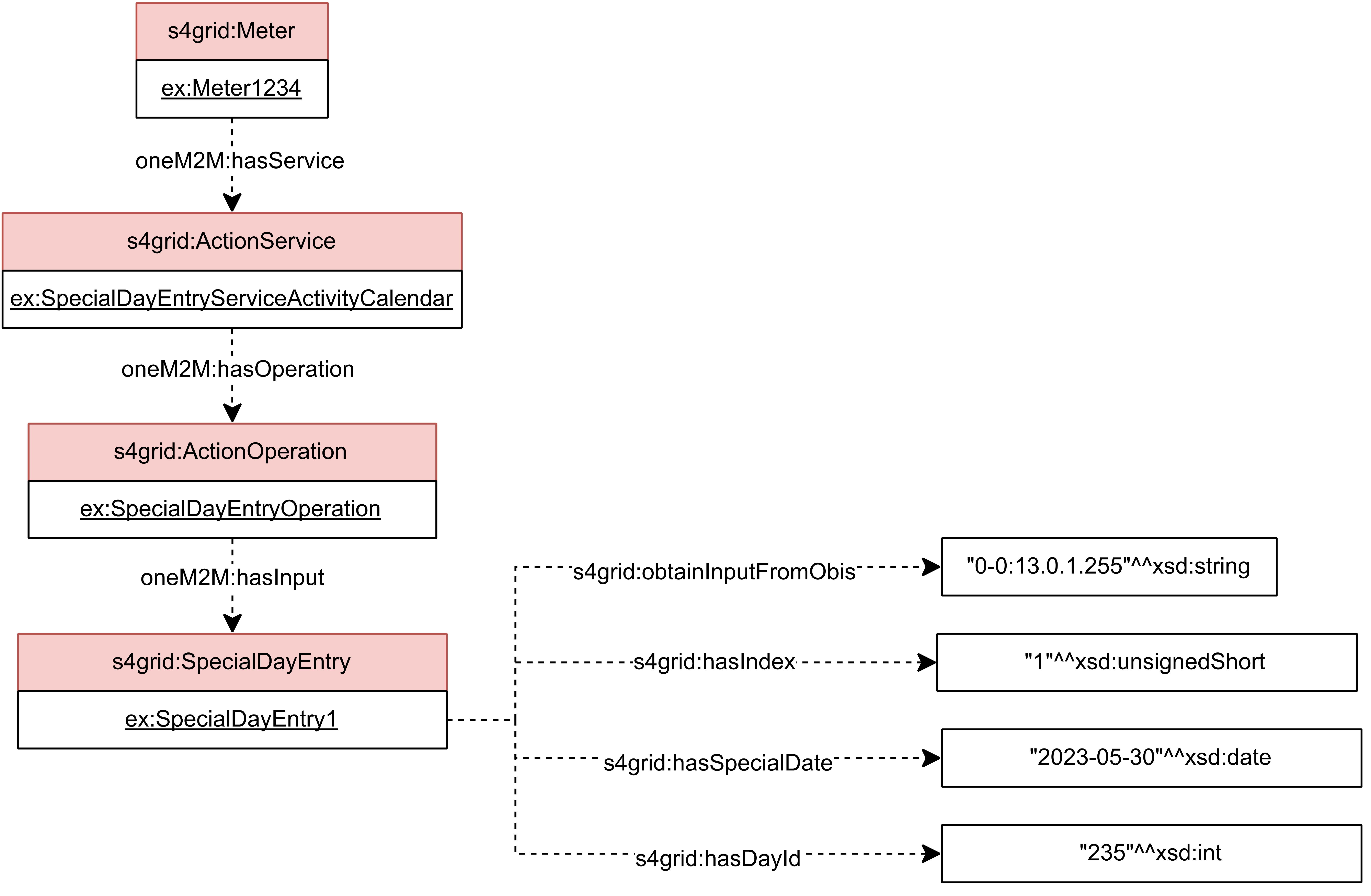
Namespace Declarations
- default namespace:
- https://saref.etsi.org/saref4grid/
- schema:
- http://schema.org/
- owl:
- http://www.w3.org/2002/07/owl#
- rdf:
- http://www.w3.org/1999/02/22-rdf-syntax-ns#
- oneM2M:
- http://www.owl-ontologies.com/oneM2M#
- saref:
- https://saref.etsi.org/core/
- xsd:
- http://www.w3.org/2001/XMLSchema#
- dcterms:
- http://purl.org/dc/terms/
- rdfs:
- http://www.w3.org/2000/01/rdf-schema#
- vann:
- http://purl.org/vocab/vann/
- s4grid:
- https://saref.etsi.org/saref4grid/
Classes
- Action Operation
- Action Service
- Activity Calendar
- Breaker State
- Clock
- Complex Action Operation Input
- Cosem Operation Input
- Day Profile
- Day Scheduled
- Energy Power Property
- Entry Descriptor
- Firmware
- Get Operation
- Get Operation Data Output
- Get Operation Object Output
- Get Operation Output
- Get Operation Property Input
- Get Service
- Meter
- Meter Property
- Network Interface
- Power Line
- Preset Adjusting Time
- Profile Generic
- Property Value
- Quality Property
- Range Descriptor
- Regular Day Profile
- Script
- Script Table
- Season Profile
- Selective Access
- Set Operation
- Set Operation Data Input
- Set Operation Obis Input
- Set Operation Object Input
- Set Service
- Simple Action Operation Input
- Single Scheduled Action
- Special Day Entry
- Special Day Profile
Action Operation back to ToC or Class ToC
IRI: https://saref.etsi.org/saref4grid/ActionOperation
- has super-classes
- oneM2M:Operationc
Action Service back to ToC or Class ToC
IRI: https://saref.etsi.org/saref4grid/ActionService
This class is a representation of an action function to a network that makes the function discoverable, registerable, remotely controllable by other devices in the network. Actions can be performed over classes that are characterised by an OBIS code
- has super-classes
- saref:Servicec
Activity Calendar back to ToC or Class ToC
IRI: https://saref.etsi.org/saref4grid/ActivityCalendar
[COSEM] This class allows handling various tariff structures in the meter. This class provides a list of scheduled actions, following the classical way of calendar-based schedules by defining seasons, weeks, etc
- has super-classes
- s4grid:hasActivatePassiveCalendarTimedp max 1
s4grid:hasCalendarNameActivedp exactly 1
s4grid:hasCalendarNamePassivedp exactly 1 - is in domain of
- s4grid:hasActivatePassiveCalendarTimec
s4grid:hasActiveSeasonProfilec
s4grid:hasCalendarNameActivec
s4grid:hasCalendarNamePassivec
s4grid:hasPassiveSeasonProfilec
s4grid:hasSeasonStartc - is in range of
- s4grid:hasActivityCalendarc
Breaker State back to ToC or Class ToC
IRI: https://saref.etsi.org/saref4grid/BreakerState
[COSEM] This class manages an internal or external disconnect unit of the meter (e.g. electricity breaker, gas valve) in order to connect or disconnect – partly or entirely – the premises of the consumer to / from the supply
- has super-classes
- saref:Statec
s4grid:hasControlModedp exactly 1
s4grid:hasControlStatedp exactly 1
s4grid:hasOutputStatedp exactly 1 - is in domain of
- s4grid:hasControlModec
s4grid:hasControlStatec
s4grid:hasOutputStatec
Clock back to ToC or Class ToC
IRI: https://saref.etsi.org/saref4grid/Clock
[COSEM] This class models the device clock, managing all information related to date and time including deviations of the local time to a generalized time reference (UTC) due to time zones and daylight-saving time schemes
- has super-classes
- s4grid:hasClockBasedp exactly 1
s4grid:hasDaylightSavingsBegindp exactly 1
s4grid:hasDaylightSavingsDeviationdp exactly 1
s4grid:hasDaylightSavingsEnableddp exactly 1
s4grid:hasDaylightSavingsEnddp exactly 1
s4grid:hasStatusdp exactly 1
s4grid:hasTimedp exactly 1
s4grid:hasTimeZonedp exactly 1 - is in domain of
- s4grid:hasClockBasec
s4grid:hasDaylightSavingsBeginc
s4grid:hasDaylightSavingsDeviationc
s4grid:hasDaylightSavingsEnabledc
s4grid:hasDaylightSavingsEndc
s4grid:hasStatusc
s4grid:hasTimec
s4grid:hasTimeZonec - is in range of
- s4grid:hasClockc
s4grid:relatedClockc
Complex Action Operation Input back to ToC or Class ToC
IRI: https://saref.etsi.org/saref4grid/ComplexActionOperationInput
This class indicates that the parameter needed by the action to operate is complex (i.e., structure)
- has super-classes
- s4grid:CosemOperationInputc
- has sub-classes
- s4grid:PresetAdjustingTimec
s4grid:SpecialDayEntryc
Cosem Operation Input back to ToC or Class ToC
IRI: https://saref.etsi.org/saref4grid/CosemOperationInput
This class specifies the instance at which a service (get, set or action) is going to be executed by indicating the OBIS code
- has super-classes
- oneM2M:OperationInputc
s4grid:obtainInputFromObisdp exactly 1 - has sub-classes
- s4grid:ComplexActionOperationInputc
s4grid:GetOperationPropertyInputc
s4grid:SetOperationDataInputc
s4grid:SetOperationObisInputc
s4grid:SetOperationObjectInputc
s4grid:SimpleActionOperationInputc - is in domain of
- s4grid:obtainInputFromObisc
Day Profile back to ToC or Class ToC
IRI: https://saref.etsi.org/saref4grid/DayProfile
[COSEM] This class represents a list of scheduled actions which are defined by a script to be executed and the corresponding activation time
- has sub-classes
- s4grid:RegularDayProfilec
s4grid:SpecialDayProfilec - is in domain of
- s4grid:hasDaySchedulec
- is in range of
- s4grid:hasDayProfilec
Day Scheduled back to ToC or Class ToC
IRI: https://saref.etsi.org/saref4grid/DaySchedule
Scheduled actions to be executed at a given time for a day profile
- has super-classes
- s4grid:executesScriptop exactly 1
s4grid:hasStartTimedp exactly 1 - is in domain of
- s4grid:hasStartTimec
- is in range of
- s4grid:hasDaySchedulec
Energy Power Property back to ToC or Class ToC
IRI: https://saref.etsi.org/saref4grid/EnergyAndPowerProperty
Class to group those properties related to the energy and power of power lines
- has super-classes
- saref:Propertyc
- has members
- s4grid:DemandRegisterni, s4grid:ActivePowerni, s4grid:Currentni, s4grid:Voltageni, s4grid:PowerFactorni, s4grid:ActiveEnergyni, s4grid:ReactivePowerni, s4grid:ReactiveEnergyni, s4grid:ApparentPowerni
Entry Descriptor back to ToC or Class ToC
IRI: https://saref.etsi.org/saref4grid/EntryDescriptor
In the case of a get service of a profile generic class a selective access can be specified. This indicates the range of entries to be retrieved from the profile generic class
- has super-classes
- s4grid:SelectiveAccessc
- is in domain of
- s4grid:obtainFromEntryc
s4grid:obtainToEntryc
Firmware back to ToC or Class ToC
IRI: https://saref.etsi.org/saref4grid/Firmware
[COSEM] This class holds identification information related to administration and maintenance of meters. They are not communication parameters but allow the device management
- has super-classes
- s4grid:hasFirmwareVersiondp exactly 1
s4grid:hasProductIddp exactly 1
s4grid:hasVendorIddp exactly 1 - is in domain of
- s4grid:hasFirmwareVersionc
s4grid:hasProductIdc
s4grid:hasVendorIdc - is in range of
- s4grid:hasFirmwarec
Get Operation back to ToC or Class ToC
IRI: https://saref.etsi.org/saref4grid/GetOperation
This class is the means of a get service to communicate in a procedure-type manner over the network (i.e. transmit data to/from other devices). It is the –machine interpretable- exposure of a –human understandable- Command to a network
- has super-classes
- oneM2M:Operationc
oneM2M:hasInputop exactly 1
oneM2M:hasOutputop exactly 1 - is in domain of
- s4grid:hasSelectiveAccessc
Get Operation Data Output back to ToC or Class ToC
IRI: https://saref.etsi.org/saref4grid/GetOperationDataOutput
This class specifies that the output of a get operation is going to be a datatype
- has super-classes
- s4grid:GetOperationOutputc
s4grid:hasOutputDataTypedp exactly 1 - is in domain of
- s4grid:hasOutputDataTypec
Get Operation Object Output back to ToC or Class ToC
IRI: https://saref.etsi.org/saref4grid/GetOperationObjectOutput
This class specifies that the output of a get operation is going to be a class
- has super-classes
- s4grid:GetOperationOutputc
s4grid:hasOutputObjectTypedp exactly 1 - is in domain of
- s4grid:hasOutputObjectTypec
Get Operation Output back to ToC or Class ToC
IRI: https://saref.etsi.org/saref4grid/GetOperationOutput
This class specifies the output of a get operation, which can be either a class or a datatype
- has super-classes
- oneM2M:OperationOutputc
- has sub-classes
- s4grid:GetOperationDataOutputc
s4grid:GetOperationObjectOutputc
Get Operation Property Input back to ToC or Class ToC
IRI: https://saref.etsi.org/saref4grid/GetOperationPropertyInput
This class specifies the object/datatype property of an instance from which data is going to be retrieved by indicating the name of the object/datatype property
- has super-classes
- s4grid:CosemOperationInputc
s4grid:obtainInputForPropertydp exactly 1
Get Service back to ToC or Class ToC
IRI: https://saref.etsi.org/saref4grid/GetService
This class is a representation of a get function to a network that makes the function discoverable, registerable, remotely controllable by other devices in the network
- has super-classes
- saref:Servicec
Meter back to ToC or Class ToC
IRI: https://saref.etsi.org/saref4grid/Meter
Metering device that remotely records real electricity consumption. This device allows to control all the information regarding consumption for any time range, automatically and remotely
- has super-classes
- saref:Meterc
s4grid:hasPropertyValueop only (s4grid:hasPropertyop only s4grid:MeterPropertyc) - is in domain of
- s4grid:hasActivityCalendarc
s4grid:hasClockc
s4grid:hasFirmwarec
s4grid:hasNetworkInterfacec
s4grid:hasProfileGenericc
s4grid:hasPropertyValuec
s4grid:hasScriptTablec
s4grid:hasSingleScheduledActionc
Meter Property back to ToC or Class ToC
IRI: https://saref.etsi.org/saref4grid/MeterProperty
Class to group those properties related to electric grid meters
- has super-classes
- saref:Propertyc
- has members
- s4grid:TimeThresholdni, s4grid:VoltageSwellNumberni, s4grid:Quadrantni, s4grid:Thresholdni, s4grid:Phaseni, s4grid:VoltageSagNumberni, s4grid:PowerQualityni, s4grid:BillingPeriodni, s4grid:PhaseAngleni, s4grid:Manufacturerni, s4grid:ProfileStatusni, s4grid:Networkni, s4grid:LongPowerFailuresNumberni, s4grid:ScreenDisplayni, s4grid:TransformerRationi, s4grid:PowerLimitni
Network Interface back to ToC or Class ToC
IRI: https://saref.etsi.org/saref4grid/NetworkInterface
[COSEM] This class holds the MAC address of the physical device (or, more generally, of a device or software). There shall be an instance of this class for each network interface of the physical device
- has super-classes
- s4grid:hasMACAddressdp exactly 1
- is in domain of
- s4grid:hasMACAddressc
- is in range of
- s4grid:hasNetworkInterfacec
Power Line back to ToC or Class ToC
IRI: https://saref.etsi.org/saref4grid/PowerLine
Interconnected network for electricity delivery from producers to consumers
- has super-classes
- saref:FeatureOfInterestc
Preset Adjusting Time back to ToC or Class ToC
IRI: https://saref.etsi.org/saref4grid/PresetAdjustingTime
This class represents the parameters that are needed by a clock to modify its time
- has super-classes
- s4grid:ComplexActionOperationInputc
s4grid:hasPresetTimedp exactly 1
s4grid:hasValidityIntervalEnddp exactly 1
s4grid:hasValidityIntervalStartdp exactly 1 - is in domain of
- s4grid:hasPresetTimec
s4grid:hasValidityIntervalEndc
s4grid:hasValidityIntervalStartc
Profile Generic back to ToC or Class ToC
IRI: https://saref.etsi.org/saref4grid/ProfileGeneric
[COSEM] This class provides a generalized concept allowing to store, sort and access data groups or data series, called capture objects. Capture objects are appropriate attributes or elements of (an) attribute(s) of COSEM objects. The capture objects are collected periodically or occasionally
- has super-classes
- s4grid:hasCapturePerioddp exactly 1
- is in domain of
- s4grid:hasCapturePeriodc
s4grid:relatedClockc
s4grid:relatedMeasurementc
s4grid:relatedPropertyValuec - is in range of
- s4grid:hasProfileGenericc
Property Value back to ToC or Class ToC
IRI: https://saref.etsi.org/saref4grid/PropertyValue
A value (which may have a unit of measurement) that is related to a property which is not observable by the meter (i.e., is not a measurement)
- is in domain of
- s4grid:hasPropertyc
s4grid:hasUnitc
s4grid:hasValuec - is in range of
- s4grid:hasPropertyValuec
s4grid:relatedPropertyValuec
Quality Property back to ToC or Class ToC
IRI: https://saref.etsi.org/saref4grid/QualityProperty
Class to group those properties related to the quality of power lines
- has super-classes
- saref:Propertyc
- has members
- s4grid:DurationVoltageSagni, s4grid:DurationLongPowerFailureni, s4grid:DurationVoltageSwellni
Range Descriptor back to ToC or Class ToC
IRI: https://saref.etsi.org/saref4grid/RangeDescriptor
In the case of a get service of a profile generic class a selective access can be specified. This indicates the range of values to be retrieved from the profile generic class
- has super-classes
- s4grid:SelectiveAccessc
- is in domain of
- s4grid:obtainFromValuec
s4grid:obtainToValuec
Regular Day Profile back to ToC or Class ToC
IRI: https://saref.etsi.org/saref4grid/RegularDayProfile
This class represents normal dates
- has super-classes
- s4grid:DayProfilec
Script back to ToC or Class ToC
IRI: https://saref.etsi.org/saref4grid/Script
[COSEM] Lists of actions to be executed by the meter
- has super-classes
- saref:Functionc
- is in range of
- s4grid:executesScriptc
s4grid:storesScriptc
Script Table back to ToC or Class ToC
IRI: https://saref.etsi.org/saref4grid/ScriptTable
This class allows modelling the triggering of a series of actions by executing scripts
- is in domain of
- s4grid:storesScriptc
- is in range of
- s4grid:hasScriptTablec
Season Profile back to ToC or Class ToC
IRI: https://saref.etsi.org/saref4grid/SeasonProfile
[COSEM] This class represents a season which is defined by its starting date and a specific day profile to be executed
- has super-classes
- s4grid:hasFridayProfileop exactly 1
s4grid:hasMondayProfileop exactly 1
s4grid:hasSaturdayProfileop exactly 1
s4grid:hasSeasonProfileNamedp exactly 1
s4grid:hasSeasonStartdp exactly 1
s4grid:hasSundayProfileop exactly 1
s4grid:hasThursdayProfileop exactly 1
s4grid:hasTuesdayProfileop exactly 1
s4grid:hasWednesdayProfileop exactly 1 - is in domain of
- s4grid:hasDayProfilec
s4grid:hasSeasonProfileNamec - is in range of
- s4grid:hasActiveSeasonProfilec
s4grid:hasPassiveSeasonProfilec
Selective Access back to ToC or Class ToC
IRI: https://saref.etsi.org/saref4grid/SelectiveAccess
The get operations property-related services typically reference the entire property. However, in the case of certain properties, selective access to only part of the property may be provided
- has super-classes
- oneM2M:OperationInputc
- has sub-classes
- s4grid:EntryDescriptorc
s4grid:RangeDescriptorc - is in range of
- s4grid:hasSelectiveAccessc
Set Operation back to ToC or Class ToC
IRI: https://saref.etsi.org/saref4grid/SetOperation
This class is the means of a set service to communicate in a procedure-type manner over the network (i.e. transmit data to/from other devices). It is the –machine interpretable- exposure of a –human understandable- Command to a network
- has super-classes
- oneM2M:Operationc
oneM2M:hasInputop exactly 1
Set Operation Data Input back to ToC or Class ToC
IRI: https://saref.etsi.org/saref4grid/SetOperationDataInput
This class specifies that just the range of a datatype property of the instance is going to be modified
- has super-classes
- s4grid:CosemOperationInputc
s4grid:hasInputDataTypedp exactly 1
s4grid:obtainInputForPropertydp exactly 1 - is in domain of
- s4grid:hasInputDataTypec
Set Operation Obis Input back to ToC or Class ToC
IRI: https://saref.etsi.org/saref4grid/SetOperationObisInput
This class specifies that the whole instance is going to be modified
- has super-classes
- s4grid:CosemOperationInputc
s4grid:hasInputObjectTypedp exactly 1
Set Operation Object Input back to ToC or Class ToC
IRI: https://saref.etsi.org/saref4grid/SetOperationObjectInput
This class specifies that just the range of an object property of the instance is going to be modified
- has super-classes
- s4grid:CosemOperationInputc
s4grid:hasInputObjectTypedp exactly 1
s4grid:obtainInputForPropertydp exactly 1
Set Service back to ToC or Class ToC
IRI: https://saref.etsi.org/saref4grid/SetService
This class is a representation of a set function to a network that makes the function discoverable, registerable, remotely controllable by other devices in the network
- has super-classes
- saref:Servicec
Simple Action Operation Input back to ToC or Class ToC
IRI: https://saref.etsi.org/saref4grid/SimpleActionOperationInput
This class indicates that the parameter needed by the action to operate is simple (i.e., integer, string, etc)
- has super-classes
- s4grid:CosemOperationInputc
s4grid:hasActionValuedp exactly 1 - is in domain of
- s4grid:hasActionValuec
Single Scheduled Action back to ToC or Class ToC
IRI: https://saref.etsi.org/saref4grid/SingleScheduledAction
[COSEM] This class allows modelling the execution of periodic actions within a meter; such actions are not necessarily linked to tariffication
- has super-classes
- s4grid:executesScriptop exactly 1
- is in domain of
- s4grid:hasExecutionTimec
- is in range of
- s4grid:hasSingleScheduledActionc
Special Day Entry back to ToC or Class ToC
IRI: https://saref.etsi.org/saref4grid/SpecialDayEntry
This class represents the parameters that are needed by an activity calendar for adding a new special day
- has super-classes
- s4grid:ComplexActionOperationInputc
s4grid:hasDayIddp exactly 1
s4grid:hasIndexdp exactly 1
s4grid:hasSpecialDatedp exactly 1 - is in domain of
- s4grid:hasDayIdc
s4grid:hasIndexc
s4grid:hasSpecialDatec
Special Day Profile back to ToC or Class ToC
IRI: https://saref.etsi.org/saref4grid/SpecialDayProfile
[COSEM] This class allows defining special dates. On such dates, a special switching behaviour overrides the normal one
- has super-classes
- s4grid:DayProfilec
s4grid:hasSpecialDayDatedp exactly 1 - is in domain of
- s4grid:hasSpecialDayDatec
Object Properties
- executes script
- has active season profile
- has activity calendar
- has clock
- has day profile
- has day schedule
- has firmware
- has friday profile
- has monday profile
- has network interface
- has passive season profile
- has profile generic
- has property
- has property value
- has saturday profile
- has script table
- has selective access
- has single scheduled action
- has special day profile
- has sunday profile
- has thursday profile
- has tuesday profile
- has unit
- has wednesday profile
- related clock
- related measurement
- related property value
- stores script
executes script back to ToC or Object Property ToC
IRI: https://saref.etsi.org/saref4grid/executesScript
[COSEM] Defines the script to be executed
- has range
- s4grid:Scriptc
has active season profile back to ToC or Object Property ToC
IRI: https://saref.etsi.org/saref4grid/hasActiveSeasonProfile
[COSEM] Contains a list of active season profiles. These season profiles form an active calendar
- has domain
- s4grid:ActivityCalendarc
- has range
- s4grid:SeasonProfilec
has activity calendar back to ToC or Object Property ToC
IRI: https://saref.etsi.org/saref4grid/hasActivityCalendar
The activity calendar of a meter
- has domain
- s4grid:Meterc
- has range
- s4grid:ActivityCalendarc
has clock back to ToC or Object Property ToC
IRI: https://saref.etsi.org/saref4grid/hasClock
The clock of the meter
- has domain
- s4grid:Meterc
- has range
- s4grid:Clockc
has day profile back to ToC or Object Property ToC
IRI: https://saref.etsi.org/saref4grid/hasDayProfile
[COSEM] Day profile for every day of the week of a season
- has sub-properties
- s4grid:hasSundayProfileop
s4grid:hasSaturdayProfileop
s4grid:hasThursdayProfileop
s4grid:hasSpecialDayProfileop
s4grid:hasWednesdayProfileop
s4grid:hasTuesdayProfileop
s4grid:hasFridayProfileop
s4grid:hasMondayProfileop - has domain
- s4grid:SeasonProfilec
- has range
- s4grid:DayProfilec
has day schedule back to ToC or Object Property ToC
IRI: https://saref.etsi.org/saref4grid/hasDaySchedule
The day schedule of a day profile
- has domain
- s4grid:DayProfilec
- has range
- s4grid:DaySchedulec
has firmware back to ToC or Object Property ToC
IRI: https://saref.etsi.org/saref4grid/hasFirmware
The firmware of the meter
- has domain
- s4grid:Meterc
- has range
- s4grid:Firmwarec
has friday profile back to ToC or Object Property ToC
IRI: https://saref.etsi.org/saref4grid/hasFridayProfile
It defines the day profile valid each Friday of the season
- has super-properties
- s4grid:hasDayProfileop
has monday profile back to ToC or Object Property ToC
IRI: https://saref.etsi.org/saref4grid/hasMondayProfile
It defines the day profile valid each Monday of the season
- has super-properties
- s4grid:hasDayProfileop
has network interface back to ToC or Object Property ToC
IRI: https://saref.etsi.org/saref4grid/hasNetworkInterface
The network interface of the meter
- has domain
- s4grid:Meterc
- has range
- s4grid:NetworkInterfacec
has passive season profile back to ToC or Object Property ToC
IRI: https://saref.etsi.org/saref4grid/hasPassiveSeasonProfile
[COSEM] Contains a list of passive season profiles. These season profiles form a passive calendar
- has domain
- s4grid:ActivityCalendarc
- has range
- s4grid:SeasonProfilec
has profile generic back to ToC or Object Property ToC
IRI: https://saref.etsi.org/saref4grid/hasProfileGeneric
The profile generic of a meter
- has domain
- s4grid:Meterc
- has range
- s4grid:ProfileGenericc
has property back to ToC or Object Property ToC
IRI: https://saref.etsi.org/saref4grid/hasProperty
A relationship between a property value and the property it relates to
- has domain
- s4grid:PropertyValuec
- has range
- saref:Propertyc
has property value back to ToC or Object Property ToC
IRI: https://saref.etsi.org/saref4grid/hasPropertyValue
The property value of a meter
- has domain
- s4grid:Meterc
- has range
- s4grid:PropertyValuec
has saturday profile back to ToC or Object Property ToC
IRI: https://saref.etsi.org/saref4grid/hasSaturdayProfile
It defines the day profile valid each Saturday of the season
- has super-properties
- s4grid:hasDayProfileop
has script table back to ToC or Object Property ToC
IRI: https://saref.etsi.org/saref4grid/hasScriptTable
The script table of a meter
- has domain
- s4grid:Meterc
- has range
- s4grid:ScriptTablec
has selective access back to ToC or Object Property ToC
IRI: https://saref.etsi.org/saref4grid/hasSelectiveAccess
The selective access of a profile generic get service
- has domain
- s4grid:GetOperationc
- has range
- s4grid:SelectiveAccessc
has single scheduled action back to ToC or Object Property ToC
IRI: https://saref.etsi.org/saref4grid/hasSingleScheduledAction
The single scheduled action of a meter
- has domain
- s4grid:Meterc
- has range
- s4grid:SingleScheduledActionc
has special day profile back to ToC or Object Property ToC
IRI: https://saref.etsi.org/saref4grid/hasSpecialDayProfile
It defines when there is a festivity and therefore a normal day behaves as a special date
- has super-properties
- s4grid:hasDayProfileop
has sunday profile back to ToC or Object Property ToC
IRI: https://saref.etsi.org/saref4grid/hasSundayProfile
It defines the day profile valid each Sunday of the season
- has super-properties
- s4grid:hasDayProfileop
has thursday profile back to ToC or Object Property ToC
IRI: https://saref.etsi.org/saref4grid/hasThursdayProfile
It defines the day profile valid each Thursday of the season
- has super-properties
- s4grid:hasDayProfileop
has tuesday profile back to ToC or Object Property ToC
IRI: https://saref.etsi.org/saref4grid/hasTuesdayProfile
It defines the day profile valid each Tuesday of the season
- has super-properties
- s4grid:hasDayProfileop
has unit back to ToC or Object Property ToC
IRI: https://saref.etsi.org/saref4grid/hasUnit
A relationship identifying the unit of measure used for a certain property value
- has domain
- s4grid:PropertyValuec
- has range
- saref:UnitOfMeasurec
has wednesday profile back to ToC or Object Property ToC
IRI: https://saref.etsi.org/saref4grid/hasWednesdayProfile
It defines the day profile valid each Wednesday of the season
- has super-properties
- s4grid:hasDayProfileop
stores script back to ToC or Object Property ToC
IRI: https://saref.etsi.org/saref4grid/storesScript
[COSEM] Specifies the different scripts which are stored in a script table
- has domain
- s4grid:ScriptTablec
- has range
- s4grid:Scriptc
Data Properties
- has action value
- has activate passive calendar time
- has calendar name active
- has calendar name passive
- has capture period
- has clock base
- has control mode
- has control state
- has day id
- has daylight savings begin
- has daylight savings deviation
- has daylight savings enabled
- has daylight savings end
- has execution time
- has firmware version
- has index
- has input data type
- has input object type
- has m a c address
- has obis
- has output data type
- has output object type
- has output state
- has preset time
- has product id
- has season profile name
- has season start
- has special date
- has special day date
- has start time
- has status
- has time
- has time zone
- has validity interval end
- has validity interval start
- has value
- has vendor id
- obtain from entry
- obtain from value
- obtain input for property
- obtain input from obis
- obtain to entry
- obtain to value
has action value back to ToC or Data Property ToC
IRI: https://saref.etsi.org/saref4grid/hasActionValue
It specifies the input of a method from the instance (COSEM object) of a class. The value of this property conforms to a simple type (not a structure)
- has domain
- s4grid:SimpleActionOperationInputc
has activate passive calendar time back to ToC or Data Property ToC
IRI: https://saref.etsi.org/saref4grid/hasActivatePassiveCalendarTime
[COSEM] Defines the time when the passive calendar will be activated
- has domain
- s4grid:ActivityCalendarc
- has range
- xsd:dateTime
has calendar name active back to ToC or Data Property ToC
IRI: https://saref.etsi.org/saref4grid/hasCalendarNameActive
[COSEM] Used defined name identifying the passive calendar. Typically contains an identifier of the active calendar (currently active), which is descriptive to the set of scripts activated by the object
- has domain
- s4grid:ActivityCalendarc
- has range
- xsd:string
has calendar name passive back to ToC or Data Property ToC
IRI: https://saref.etsi.org/saref4grid/hasCalendarNamePassive
[COSEM] User defined name identifying the passive calendar. Typically contains an identifier of the passive calendar (will be activated), which is descriptive to the set of scripts activated by the object
- has domain
- s4grid:ActivityCalendarc
- has range
- xsd:string
has capture period back to ToC or Data Property ToC
IRI: https://saref.etsi.org/saref4grid/hasCapturePeriod
[COSEM] The capturing period of a profile generic in seconds. If its value is 0, then there is not automatic capturing; capturing is triggered externally or through capture events occur asynchronously. If its value is greater than 0, then automatic capturing is assumed
- has domain
- s4grid:ProfileGenericc
- has range
- xsd:int
has clock base back to ToC or Data Property ToC
IRI: https://saref.etsi.org/saref4grid/hasClockBase
[COSEM] Defines where the basic timing information comes from: (0) not defined, (1) internal crystal, (2) mains frequency 50 Hz, (3) mains frequency 60 Hz, (4) GPS (global positioning system), (5) radio controlled
- has domain
- s4grid:Clockc
- has range
- xsd:int
has control mode back to ToC or Data Property ToC
IRI: https://saref.etsi.org/saref4grid/hasControlMode
[COSEM] Configures the behaviour of the disconnect control object for all triggers, i.e. the possible state transitions
- has domain
- s4grid:BreakerStatec
- has range
- xsd:int
has control state back to ToC or Data Property ToC
IRI: https://saref.etsi.org/saref4grid/hasControlState
Shows the internal state of the disconnect control object: (0) Disconnected, (1) Connected, (2) Ready for reconnection
- has domain
- s4grid:BreakerStatec
- has range
- xsd:int
has day id back to ToC or Data Property ToC
IRI: https://saref.etsi.org/saref4grid/hasDayId
It defines the unique identifier of a day
- has domain
- s4grid:SpecialDayEntryc
- has range
- xsd:int
has daylight savings begin back to ToC or Data Property ToC
IRI: https://saref.etsi.org/saref4grid/hasDaylightSavingsBegin
[COSEM] Defines the local switch date and time when the local time starts to deviate from the normal time
- has domain
- s4grid:Clockc
- has range
- xsd:dateTime
has daylight savings deviation back to ToC or Data Property ToC
IRI: https://saref.etsi.org/saref4grid/hasDaylightSavingsDeviation
[COSEM] Contains the number of minutes by which the deviation in generalized time shall be corrected at daylight savings begin
- has domain
- s4grid:Clockc
- has range
- xsd:integer
has daylight savings enabled back to ToC or Data Property ToC
IRI: https://saref.etsi.org/saref4grid/hasDaylightSavingsEnabled
[COSEM] Enable and disable the daylight savings time feature
- has domain
- s4grid:Clockc
- has range
- xsd:boolean
has daylight savings end back to ToC or Data Property ToC
IRI: https://saref.etsi.org/saref4grid/hasDaylightSavingsEnd
[COSEM] Defines the local switch date and time when the local time ends to deviate from the local normal time
- has domain
- s4grid:Clockc
- has range
- xsd:dateTime
has execution time back to ToC or Data Property ToC
IRI: https://saref.etsi.org/saref4grid/hasExecutionTime
[COSEM] Specifies the time and the date when the script is executed
- has domain
- s4grid:SingleScheduledActionc
- has range
- xsd:dateTime
has firmware version back to ToC or Data Property ToC
IRI: https://saref.etsi.org/saref4grid/hasFirmwareVersion
[COSEM] Textual description of the firmware version running on the device
- has domain
- s4grid:Firmwarec
- has range
- xsd:string
has index back to ToC or Data Property ToC
IRI: https://saref.etsi.org/saref4grid/hasIndex
It defines the index of the special day
- has domain
- s4grid:SpecialDayEntryc
- has range
- xsd:unsignedShort
has input data type back to ToC or Data Property ToC
IRI: https://saref.etsi.org/saref4grid/hasInputDataType
It identifies the type of the attribute of an instance (COSEM object) of a class from which the data is going to be obtained. The value of this property conforms to the range of a datatype property of SAREF4GRID
- has domain
- s4grid:SetOperationDataInputc
- has range
- xsd:string
has input object type back to ToC or Data Property ToC
IRI: https://saref.etsi.org/saref4grid/hasInputObjectType
It identifies the type of the attribute of an instance (COSEM object) of a class from which the data is going to be obtained. The value of this property conforms to the range of an object property of SAREF4GRID
- has range
- xsd:string
has m a c address back to ToC or Data Property ToC
IRI: https://saref.etsi.org/saref4grid/hasMACAddress
[COSEM] Holds the MAC address
- has domain
- s4grid:NetworkInterfacec
- has range
- xsd:string
has obis back to ToC or Data Property ToC
IRI: https://saref.etsi.org/saref4grid/hasObis
[COSEM] It identifies the instance (COSEM object) of a class. The value of this property conforms to OBIS. OBject Identification System (OBIS) provides a unique identifier for all data within the metering equipment, including not only measurement values, but also abstract values used for configuration or obtaining information about the behaviour of the metering equipment
- has range
- xsd:string
has output data type back to ToC or Data Property ToC
IRI: https://saref.etsi.org/saref4grid/hasOutputDataType
It identifies the type of the attribute of an instance (COSEM object) of a class from which the data is going to be obtained. The value of this property conforms to the range of a datatype property of SAREF4GRID
- has domain
- s4grid:GetOperationDataOutputc
- has range
- xsd:string
has output object type back to ToC or Data Property ToC
IRI: https://saref.etsi.org/saref4grid/hasOutputObjectType
It identifies the type of the attribute of an instance (COSEM object) of a class from which the data is going to be obtained. The value of this property conforms to the range of an object property of SAREF4GRID
- has domain
- s4grid:GetOperationObjectOutputc
- has range
- xsd:string
has output state back to ToC or Data Property ToC
IRI: https://saref.etsi.org/saref4grid/hasOutputState
[COSEM] Shows the actual physical state of the device connection to the supply: (True) Connected, (False) Disconnected
- has domain
- s4grid:BreakerStatec
- has range
- xsd:boolean
has preset time back to ToC or Data Property ToC
IRI: https://saref.etsi.org/saref4grid/hasPresetTime
It pre-sets the clock time to a new value
- has domain
- s4grid:PresetAdjustingTimec
- has range
- xsd:dateTime
has product id back to ToC or Data Property ToC
IRI: https://saref.etsi.org/saref4grid/hasProductId
[COSEM] Vendor-assigned unique identifier for the specific product
- has domain
- s4grid:Firmwarec
- has range
- xsd:unsignedShort
has season profile name back to ToC or Data Property ToC
IRI: https://saref.etsi.org/saref4grid/hasSeasonProfileName
[COSEM] User defined name identifying the current season profile
- has domain
- s4grid:SeasonProfilec
- has range
- xsd:string
has season start back to ToC or Data Property ToC
IRI: https://saref.etsi.org/saref4grid/hasSeasonStart
[COSEM] Starting time of the season profile. The current season profile is terminated by the starting time of the next season
- has domain
- s4grid:ActivityCalendarc
- has range
- xsd:dateTime
has special date back to ToC or Data Property ToC
IRI: https://saref.etsi.org/saref4grid/hasSpecialDate
It defines the date at which a normal day is considered a special date
- has domain
- s4grid:SpecialDayEntryc
- has range
- xsd:date
has special day date back to ToC or Data Property ToC
IRI: https://saref.etsi.org/saref4grid/hasSpecialDayDate
Dates at which a normal day is considered a special date (i.e., Christmas)
- has domain
- s4grid:SpecialDayProfilec
- has range
- xsd:date
has start time back to ToC or Data Property ToC
IRI: https://saref.etsi.org/saref4grid/hasStartTime
[COSEM] Time when the script is going to be executed
- has domain
- s4grid:DaySchedulec
- has range
- xsd:time
has status back to ToC or Data Property ToC
IRI: https://saref.etsi.org/saref4grid/hasStatus
[COSEM] Status of the clock
- has domain
- s4grid:Clockc
- has range
- xsd:int
has time back to ToC or Data Property ToC
IRI: https://saref.etsi.org/saref4grid/hasTime
[COSEM] Meter’s local date and time
- has domain
- s4grid:Clockc
- has range
- xsd:dateTime
has time zone back to ToC or Data Property ToC
IRI: https://saref.etsi.org/saref4grid/hasTimeZone
[COSEM] The deviation of local, normal time to UTC in minutes. The value depends on the geographical location of the meter
- has domain
- s4grid:Clockc
- has range
- xsd:long
has validity interval end back to ToC or Data Property ToC
IRI: https://saref.etsi.org/saref4grid/hasValidityIntervalEnd
It defines the end of a validity interval within which the new time can be activated
- has domain
- s4grid:PresetAdjustingTimec
- has range
- xsd:dateTime
has validity interval start back to ToC or Data Property ToC
IRI: https://saref.etsi.org/saref4grid/hasValidityIntervalStart
It defines the start of a validity interval within which the new time can be activated
- has domain
- s4grid:PresetAdjustingTimec
- has range
- xsd:dateTime
has value back to ToC or Data Property ToC
IRI: https://saref.etsi.org/saref4grid/hasValue
A relationship defining the value of a certain property which is not observable by the meter
- has domain
- s4grid:PropertyValuec
has vendor id back to ToC or Data Property ToC
IRI: https://saref.etsi.org/saref4grid/hasVendorId
[COSEM] Unique vendor identifier assigned by the PRIME Alliance
- has domain
- s4grid:Firmwarec
- has range
- xsd:unsignedShort
obtain from entry back to ToC or Data Property ToC
IRI: https://saref.etsi.org/saref4grid/obtainFromEntry
It defines the first entry to be retrieved from a profile generic
- has domain
- s4grid:EntryDescriptorc
- has range
- xsd:unsignedLong
obtain from value back to ToC or Data Property ToC
IRI: https://saref.etsi.org/saref4grid/obtainFromValue
It restricts the range of entries to be retrieved from a profile generic defining the oldest or smallest entry to retrieve
- has domain
- s4grid:RangeDescriptorc
obtain input for property back to ToC or Data Property ToC
IRI: https://saref.etsi.org/saref4grid/obtainInputForProperty
It identifies the attribute of an instance (COSEM object) of a class from which the data is going to be obtained. The value of this property conforms to and object property or datatype property of SAREF4GRID
- has range
- xsd:string
obtain input from obis back to ToC or Data Property ToC
IRI: https://saref.etsi.org/saref4grid/obtainInputFromObis
It identifies the instance (COSEM object) of a class from which the data is going to be obtained. The value of this property conforms to OBIS
- has domain
- s4grid:CosemOperationInputc
- has range
- xsd:string
obtain to entry back to ToC or Data Property ToC
IRI: https://saref.etsi.org/saref4grid/obtainToEntry
It defines the last entry to be retrieved from a profile generic
- has domain
- s4grid:EntryDescriptorc
- has range
- xsd:unsignedLong
obtain to value back to ToC or Data Property ToC
IRI: https://saref.etsi.org/saref4grid/obtainToValue
It restricts the range of entries to be retrieved from a profile generic defining the newest or largest entry to retrieve
- has domain
- s4grid:RangeDescriptorc
Named Individuals
- Active Energy
- Active Power
- Apparent Power
- Billing Period
- Current
- Demand Register
- Duration Long Power Failure
- Duration Voltage Sag
- Duration Voltage Swell
- Long Power Failures Number
- Manufacturer
- Network
- Phase
- Phase Angle
- Power Factor
- Power Limit
- Power Quality
- Profile Status
- Quadrant
- Reactive Energy
- Reactive Power
- Screen Display
- Threshold
- Time Threshold
- Transformer Ratio
- Voltage
- Voltage Sag Number
- Voltage Swell Number
Active Energy back to ToC or Named Individuals ToC
IRI: https://saref.etsi.org/saref4grid/ActiveEnergy
Property of the power line indicating its active energy
- belongs to
- s4grid:EnergyAndPowerPropertyc
Active Power back to ToC or Named Individuals ToC
IRI: https://saref.etsi.org/saref4grid/ActivePower
Property of the power line indicating its active power
- belongs to
- s4grid:EnergyAndPowerPropertyc
Apparent Power back to ToC or Named Individuals ToC
IRI: https://saref.etsi.org/saref4grid/ApparentPower
Property of the power line indicating its apparent power
- belongs to
- s4grid:EnergyAndPowerPropertyc
Billing Period back to ToC or Named Individuals ToC
IRI: https://saref.etsi.org/saref4grid/BillingPeriod
Property of the meter that indicates the period in which a given billing is being applied
- belongs to
- s4grid:MeterPropertyc
Current back to ToC or Named Individuals ToC
IRI: https://saref.etsi.org/saref4grid/Current
Property of the power line indicating its current
- belongs to
- s4grid:EnergyAndPowerPropertyc
Demand Register back to ToC or Named Individuals ToC
IRI: https://saref.etsi.org/saref4grid/DemandRegister
Property of the power line indicating its demand register
- belongs to
- s4grid:EnergyAndPowerPropertyc
Duration Long Power Failure back to ToC or Named Individuals ToC
IRI: https://saref.etsi.org/saref4grid/DurationLongPowerFailure
Property of the power line indicating the duration of the long power failures detected
- belongs to
- s4grid:QualityPropertyc
Duration Voltage Sag back to ToC or Named Individuals ToC
IRI: https://saref.etsi.org/saref4grid/DurationVoltageSag
Property of the power line indicating the duration of the voltage sags detected
- belongs to
- s4grid:QualityPropertyc
Duration Voltage Swell back to ToC or Named Individuals ToC
IRI: https://saref.etsi.org/saref4grid/DurationVoltageSwell
Property of the power line indicating the duration of the voltage swells detected
- belongs to
- s4grid:QualityPropertyc
Long Power Failures Number back to ToC or Named Individuals ToC
IRI: https://saref.etsi.org/saref4grid/LongPowerFailuresNumber
Property of the meter indicating the number of long power failures detected
- belongs to
- s4grid:MeterPropertyc
Manufacturer back to ToC or Named Individuals ToC
IRI: https://saref.etsi.org/saref4grid/Manufacturer
Property of the meter indicating its manufacturer information
- belongs to
- s4grid:MeterPropertyc
Network back to ToC or Named Individuals ToC
IRI: https://saref.etsi.org/saref4grid/Network
Property of the meter indicating its network information
- belongs to
- s4grid:MeterPropertyc
Phase back to ToC or Named Individuals ToC
IRI: https://saref.etsi.org/saref4grid/Phase
Property of the meter indicating its phase
- belongs to
- s4grid:MeterPropertyc
Phase Angle back to ToC or Named Individuals ToC
IRI: https://saref.etsi.org/saref4grid/PhaseAngle
Property of the meter indicating its phase angle
- belongs to
- s4grid:MeterPropertyc
Power Factor back to ToC or Named Individuals ToC
IRI: https://saref.etsi.org/saref4grid/PowerFactor
Property of the power line indicating its power factor
- belongs to
- s4grid:EnergyAndPowerPropertyc
Power Limit back to ToC or Named Individuals ToC
IRI: https://saref.etsi.org/saref4grid/PowerLimit
Property of the meter indicating its power limit
- belongs to
- s4grid:MeterPropertyc
Power Quality back to ToC or Named Individuals ToC
IRI: https://saref.etsi.org/saref4grid/PowerQuality
Property of the meter indicating its power quality
- belongs to
- s4grid:MeterPropertyc
Profile Status back to ToC or Named Individuals ToC
IRI: https://saref.etsi.org/saref4grid/ProfileStatus
Property of the meter indicating its profile generic status
- belongs to
- s4grid:MeterPropertyc
Quadrant back to ToC or Named Individuals ToC
IRI: https://saref.etsi.org/saref4grid/Quadrant
Property of the meter indicating its quadrant
- belongs to
- s4grid:MeterPropertyc
Reactive Energy back to ToC or Named Individuals ToC
IRI: https://saref.etsi.org/saref4grid/ReactiveEnergy
Property of the power line indicating its reactive energy
- belongs to
- s4grid:EnergyAndPowerPropertyc
Reactive Power back to ToC or Named Individuals ToC
IRI: https://saref.etsi.org/saref4grid/ReactivePower
Property of the power line indicating its reactive power
- belongs to
- s4grid:EnergyAndPowerPropertyc
Screen Display back to ToC or Named Individuals ToC
IRI: https://saref.etsi.org/saref4grid/ScreenDisplay
Property of the meter indicating information about its screen
- belongs to
- s4grid:MeterPropertyc
Threshold back to ToC or Named Individuals ToC
IRI: https://saref.etsi.org/saref4grid/Threshold
Property of the meter indicating a threshold limit
- belongs to
- s4grid:MeterPropertyc
Time Threshold back to ToC or Named Individuals ToC
IRI: https://saref.etsi.org/saref4grid/TimeThreshold
Property of the meter indicating the time outside a threshold
- belongs to
- s4grid:MeterPropertyc
Transformer Ratio back to ToC or Named Individuals ToC
IRI: https://saref.etsi.org/saref4grid/TransformerRatio
Property of the meter indicating the transformer turn ratio
- belongs to
- s4grid:MeterPropertyc
Voltage back to ToC or Named Individuals ToC
IRI: https://saref.etsi.org/saref4grid/Voltage
Property of the power line indicating its voltage
- belongs to
- s4grid:EnergyAndPowerPropertyc
Voltage Sag Number back to ToC or Named Individuals ToC
IRI: https://saref.etsi.org/saref4grid/VoltageSagNumber
Property of the meter indicating the number of voltage sags detected
- belongs to
- s4grid:MeterPropertyc
Voltage Swell Number back to ToC or Named Individuals ToC
IRI: https://saref.etsi.org/saref4grid/VoltageSwellNumber
Property of the meter indicating the number of voltage swells detected
- belongs to
- s4grid:MeterPropertyc
This documentation page was generated automatically using SPARQL-Generate, developed by Maxime Lefrançois. The SAREF public portal, the SAREF sources with continuous integration and deployment, the SAREF Pipeline software, and ETSI Technical Specification TS 103 673 v1.1.1 "SAREF Development Framework and Workflow, Streamlining the Development of SAREF and its Extensions", have been developed in the context of the ETSI STF 578, which followed the ETSI STF 556.







This class is the means of an action service to communicate in a procedure-type manner over the network (i.e. transmit data to/from other devices). It is the –machine interpretable- exposure of a –human understandable- Command to a network